Broadcom BRCM1013 802.11g Mini-PCI Card User Manual Startup Guide
Broadcom Corporation 802.11g Mini-PCI Card Startup Guide
Broadcom >
Contents
HP Start up Guide
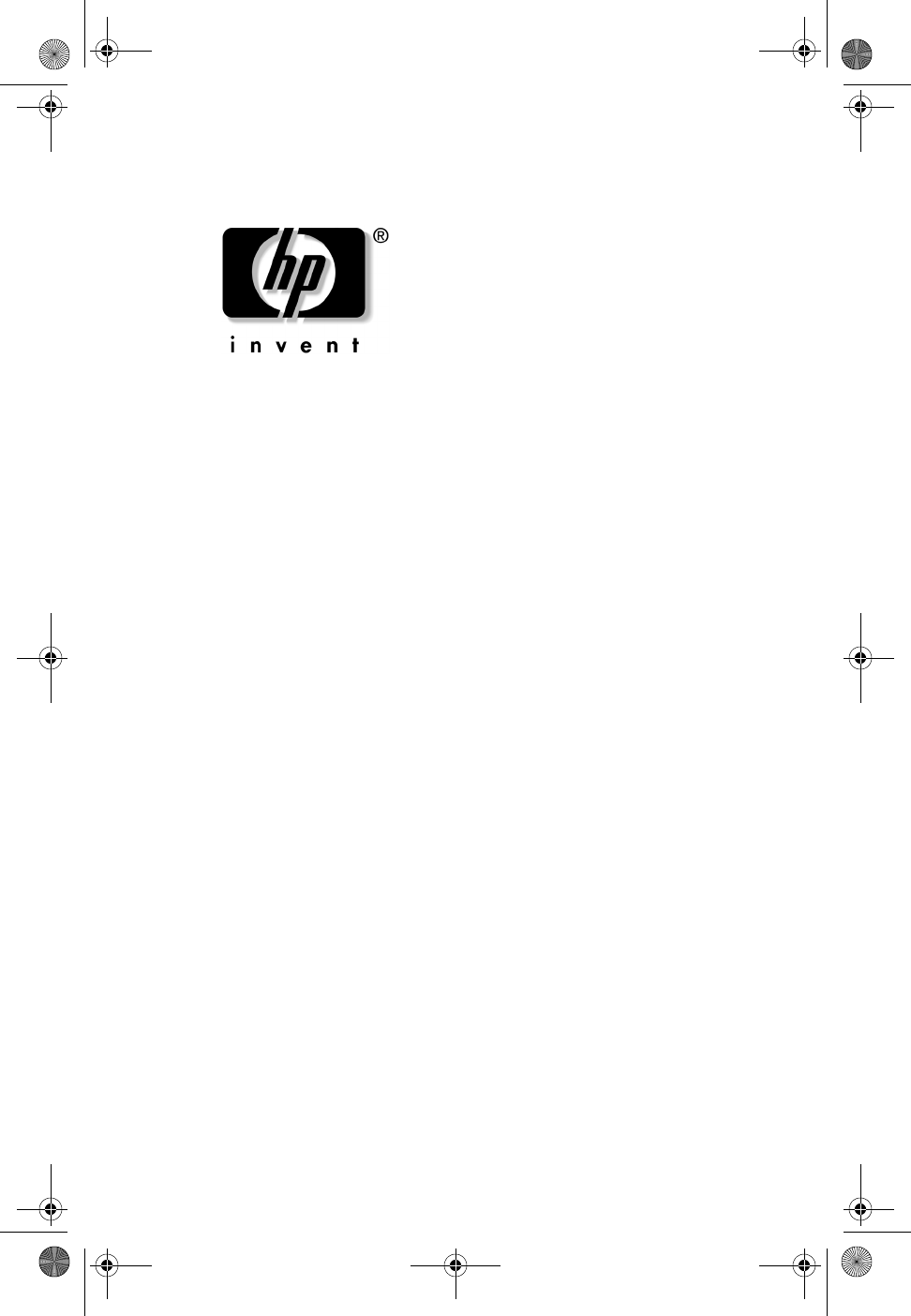
Startup Guide
HP Notebook Series
Document Part Number: 370699-001
June 2004
This guide explains how to set up your notebook and begin using
it. It also provides battery pack, power management, and
troubleshooting information.
HP_SU_370699-001.book Page i Thursday, May 13, 2004 4:39 PM

© Copyright 2004 Hewlett-Packard Development Company, L.P.
Microsoft and Windows are U.S. registered trademarks of Microsoft
Corporation. Adobe and Acrobat are trademarks of Adobe Systems
Incorporated.
The information contained herein is subject to change without notice. The
only warranties for HP products and services are set forth in the express
warranty statements accompanying such products and services. Nothing
herein should be construed as constituting an additional warranty. HP shall
not be liable for technical or editorial errors or omissions contained herein.
Startup Guide
HP Notebook Series
First Edition June 2004
Reference Number: ze4900/nx9020/nx9030/nx9040
Document Part Number: 370699-001
HP_SU_370699-001.book Page ii Thursday, May 13, 2004 4:39 PM
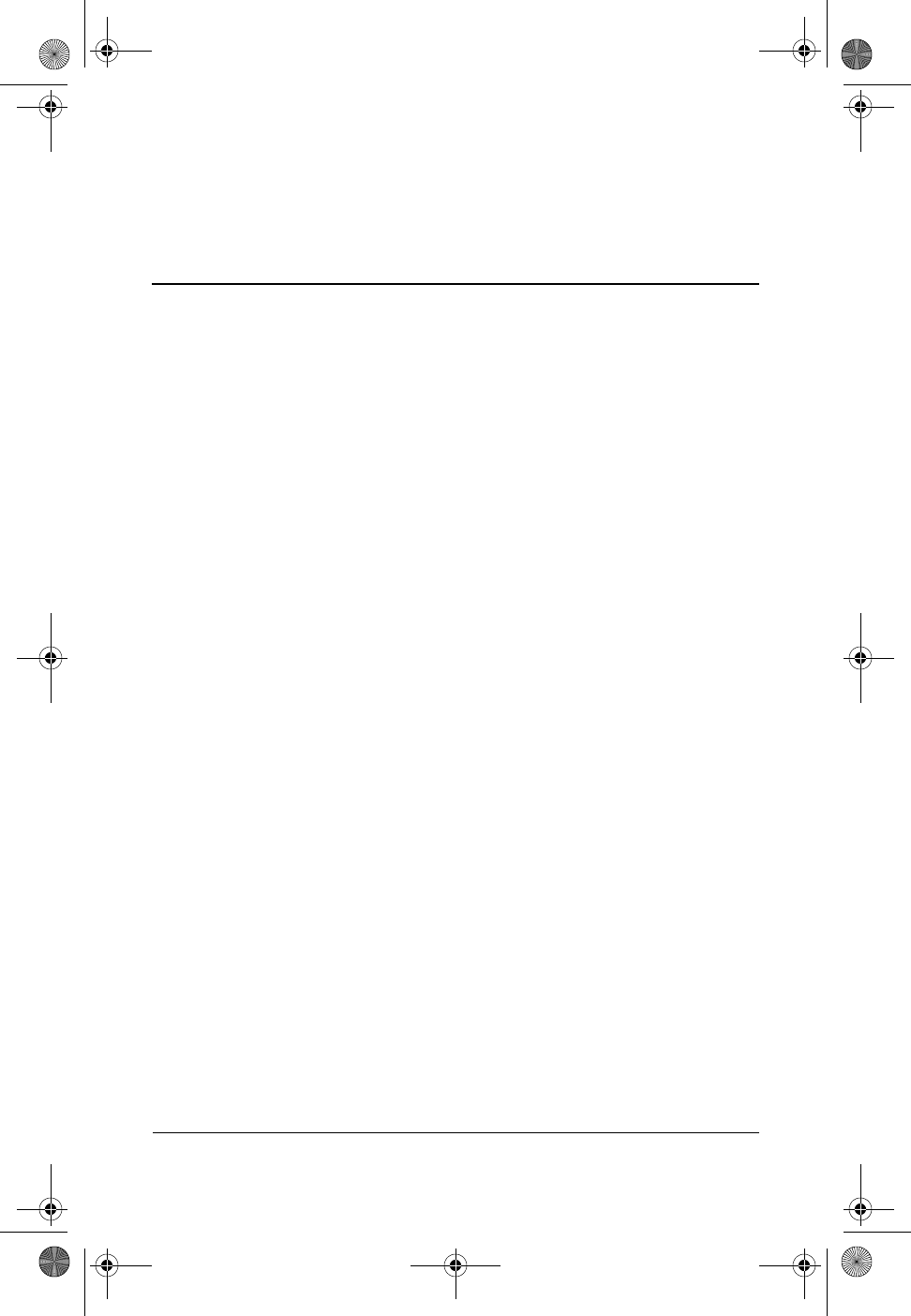
Startup Guide iii
Contents
1 Getting Started with Your Notebook
Important Safety Information. . . . . . . . . . . . . . . . . . . . . . 1–1
Identifying Parts of the Notebook . . . . . . . . . . . . . . . . . . 1–2
Front Panel and Right Panel Components . . . . . . . . 1–3
Left Panel and Back Panel Components . . . . . . . . . . 1–4
Bottom Panel Components . . . . . . . . . . . . . . . . . . . . 1–5
Status Lights . . . . . . . . . . . . . . . . . . . . . . . . . . . . . . . 1–6
Setting Up Your Notebook. . . . . . . . . . . . . . . . . . . . . . . . 1–8
Step 1: Insert the Battery Pack . . . . . . . . . . . . . . . . . 1–8
Step 2: Connect AC Power . . . . . . . . . . . . . . . . . . . . 1–9
Step 3: Connect a Phone Line . . . . . . . . . . . . . . . . . 1–10
Step 4: Turn On the Notebook. . . . . . . . . . . . . . . . . 1–11
Step 5: Set Up Windows . . . . . . . . . . . . . . . . . . . . . 1–12
Using the Documentation CD . . . . . . . . . . . . . . . . . . . . 1–12
2Basic Operation
Operating Your Notebook . . . . . . . . . . . . . . . . . . . . . . . . 2–1
Default Power Settings . . . . . . . . . . . . . . . . . . . . . . . 2–2
To Reset the Notebook . . . . . . . . . . . . . . . . . . . . . . . 2–3
To Change the Boot Device. . . . . . . . . . . . . . . . . . . . 2–3
To Use the TouchPad . . . . . . . . . . . . . . . . . . . . . . . . 2–4
To Use the Tap to Click Function of the
TouchPad. . . . . . . . . . . . . . . . . . . . . . . . . . . . . . . . . . 2–5
To Use the Function Hot Keys . . . . . . . . . . . . . . . . . 2–6
Using CDs or DVDs. . . . . . . . . . . . . . . . . . . . . . . . . . . . . 2–7
To Play DVD Movies . . . . . . . . . . . . . . . . . . . . . . . . 2–7
HP_SU_370699-001.book Page iii Thursday, May 13, 2004 4:39 PM
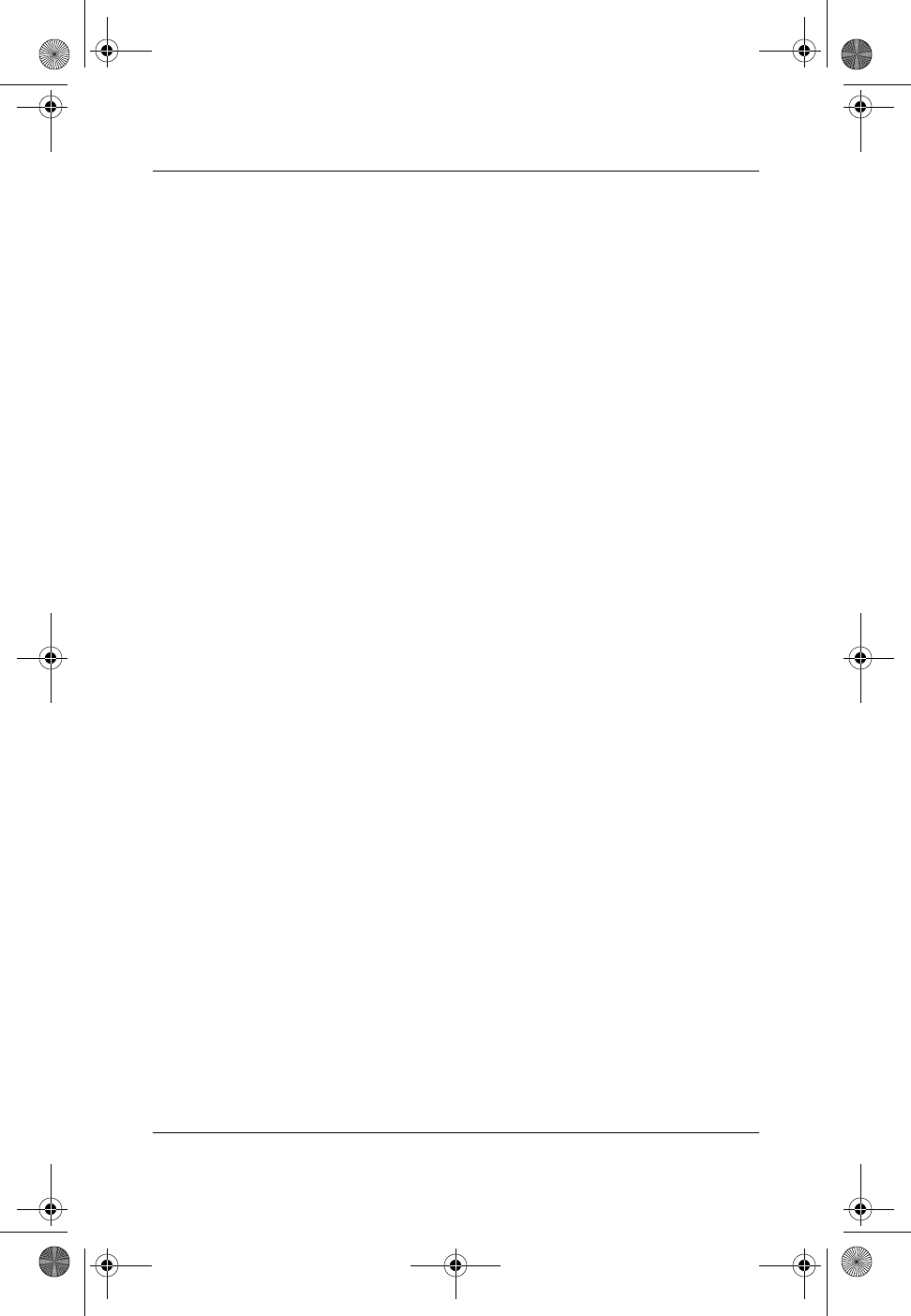
iv Startup Guide
Contents
To Write to DVD Media (Select Models Only) . . . . 2–7
To Connect a TV to Your Notebook
(Select Models Only). . . . . . . . . . . . . . . . . . . . . . . . . 2–8
To Connect an Infrared Device (Select Models
Only) . . . . . . . . . . . . . . . . . . . . . . . . . . . . . . . . . . . . . 2–8
3 Battery Packs and Power Management
Using Battery Power . . . . . . . . . . . . . . . . . . . . . . . . . . . . 3–1
To Check Battery Status . . . . . . . . . . . . . . . . . . . . . . 3–1
To Respond to a Low-Battery Warning . . . . . . . . . . 3–2
To Recharge the Battery Pack . . . . . . . . . . . . . . . . . . 3–3
To Get the Most from Your Battery Packs . . . . . . . . 3–3
Disposing of a Used Battery Pack . . . . . . . . . . . . . . . . . . 3–5
4Troubleshooting
Troubleshooting Your Notebook . . . . . . . . . . . . . . . . . . . 4–1
Display Problems. . . . . . . . . . . . . . . . . . . . . . . . . . . . 4–2
Hard Drive Problems. . . . . . . . . . . . . . . . . . . . . . . . . 4–3
Keyboard and Pointing Device Problems . . . . . . . . . 4–3
Power and Battery Pack Problems. . . . . . . . . . . . . . . 4–5
Startup Problems . . . . . . . . . . . . . . . . . . . . . . . . . . . . 4–6
Configuring Your Notebook . . . . . . . . . . . . . . . . . . . . . . 4–7
To Run the BIOS Setup Utility . . . . . . . . . . . . . . . . . 4–7
Updating Software and Drivers from the Web . . . . . . . . 4–8
Using System Recovery Features. . . . . . . . . . . . . . . . . . . 4–8
Safeguarding Your Data . . . . . . . . . . . . . . . . . . . . . . 4–9
Operating System (OS) CD Repair . . . . . . . . . . . . . 4–10
OS CD Reinstall . . . . . . . . . . . . . . . . . . . . . . . . . . . 4–11
Reinstalling Drivers. . . . . . . . . . . . . . . . . . . . . . . . . 4–12
Restoring Software Applications. . . . . . . . . . . . . . . 4–12
Index
HP_SU_370699-001.book Page iv Thursday, May 13, 2004 4:39 PM
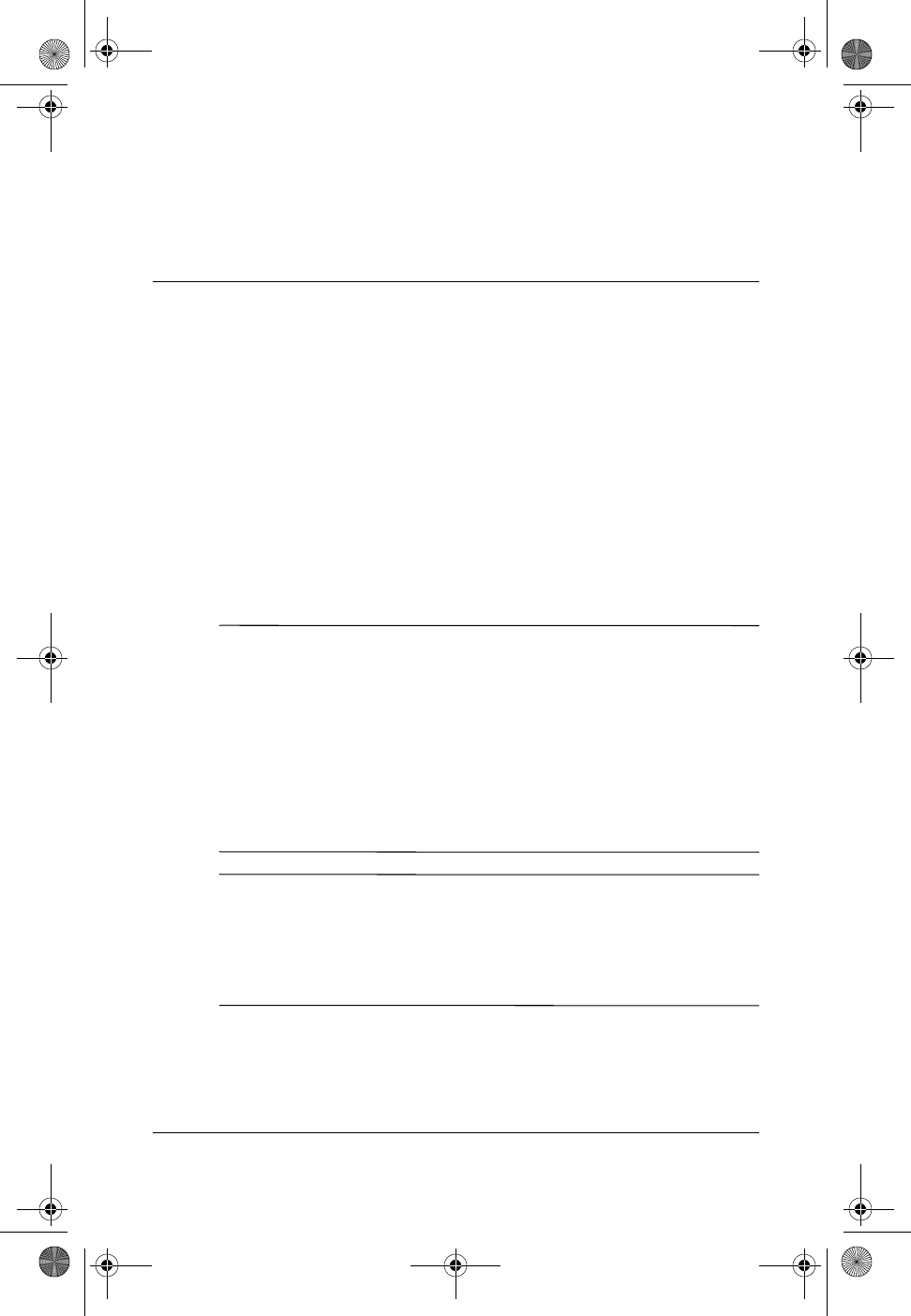
Startup Guide 1–1
1
Getting Started with
Your Notebook
Important Safety Information
This equipment has been tested and found to comply with the
limits for a Class B digital device, pursuant to Part 15 of the
FCC Rules. For more information, refer to the Regulatory and
Safety Notices on the Documentation CD provided with your
product.
ÅWARNING: To reduce the risk of electric shock or damage to your
equipment:
■Plug the power cord into an electrical outlet that is easily accessible
at all times.
■Disconnect power from the product by unplugging the power cord
from the electrical outlet.
■If provided with a three-conductor power cord having a three-pin
attachment plug, plug the cord into a grounded (earthed) outlet. Do
not disable the power cord grounding pin. The grounding pin is an
important safety feature.
ÅWARNING: To reduce the risk of serious injury, read the Safety &
Comfort Guide. It describes proper workstation setup, posture, and
health and work habits for computer users, and provides important
electrical and mechanical safety information. This guide is located on
the Web at http://www.hp.com/ergo and on the hard drive or on the
Documentation CD that is included with the product.
HP_SU_370699-001.book Page 1 Thursday, May 13, 2004 4:39 PM
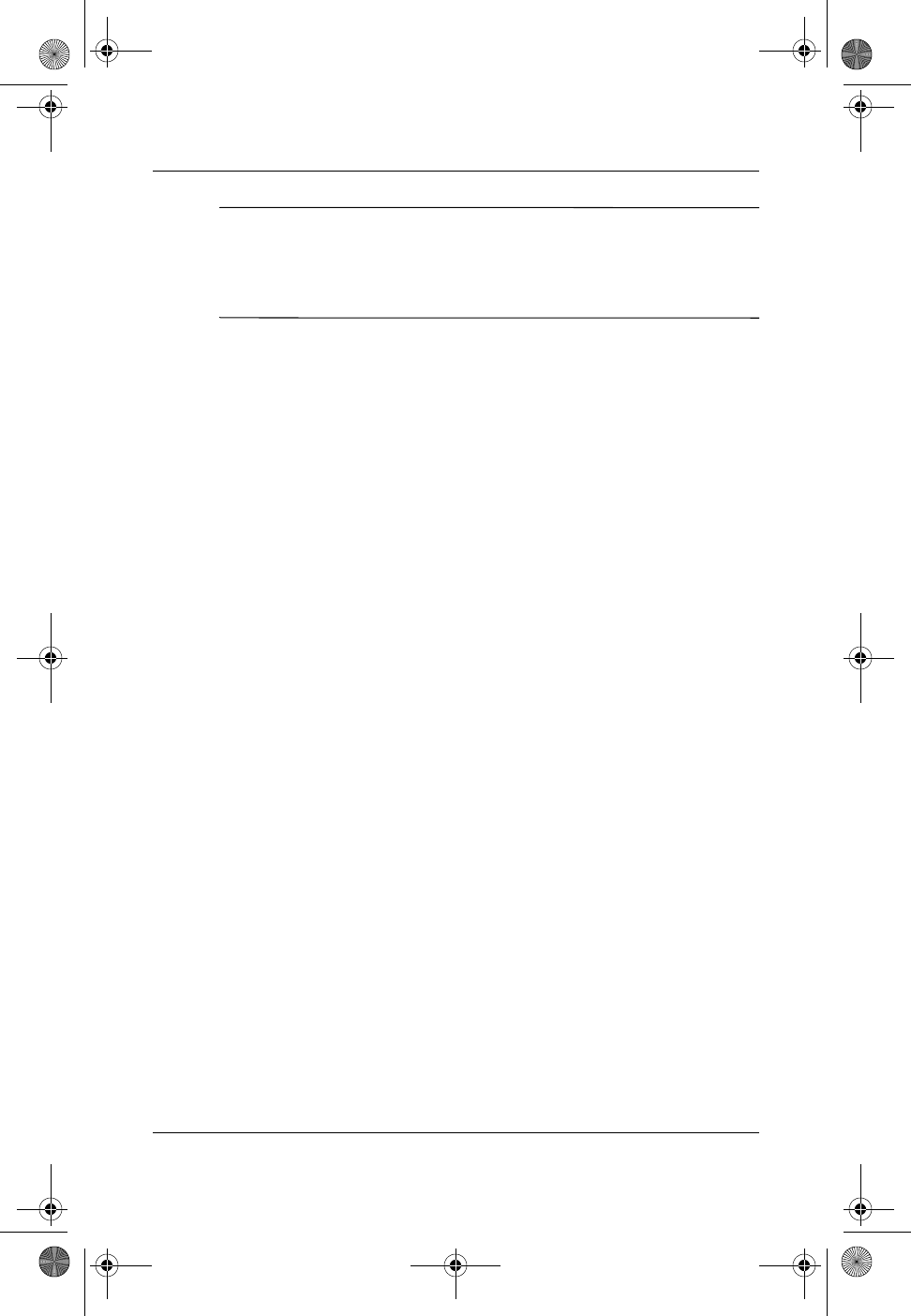
1–2 Startup Guide
Getting Started with Your Notebook
ÄCAUTION: To reduce the risk of fire, use only No. 26 AWG or
larger telecommunications line cord to connect a modem to the
telephone wall jack. In Australia, the notebook must be connected to
the Telecommunication Network through a line cord that meets the
requirements of ACA Technical Standard TS008.
When using your notebook with a telephone connection, always
follow basic safety precautions to reduce the risk of fire, electrical
shock, and injury to persons.
■Do not use this product with a telephone connection near
water (for example, near a bathtub, sink, swimming pool, or
in a wet basement).
■Avoid using a telephone connection (other than a cordless
type) during an electrical storm. There may be a remote risk
of electrical shock from lightning.
■Do not use a telephone connection to report a gas leak in the
vicinity of the leak.
■Use only the power cord and battery packs indicated in this
guide. Do not dispose of battery packs in a fire. They may
explode. Check with local codes for possible special disposal
instructions.
■Disconnect the modem cable before opening the notebook
case or touching an uninsulated modem cable, jack, or
internal component.
■Do not plug a modem cable or telephone cable into the
network (LAN) receptacle.
Identifying Parts of the Notebook
Components included with the notebook may vary by
geographical region and the features you selected. The following
tables identify the standard external components included with
most notebook models.
Find the illustrations that closely match your notebook to identify
your components.
HP_SU_370699-001.book Page 2 Thursday, May 13, 2004 4:39 PM
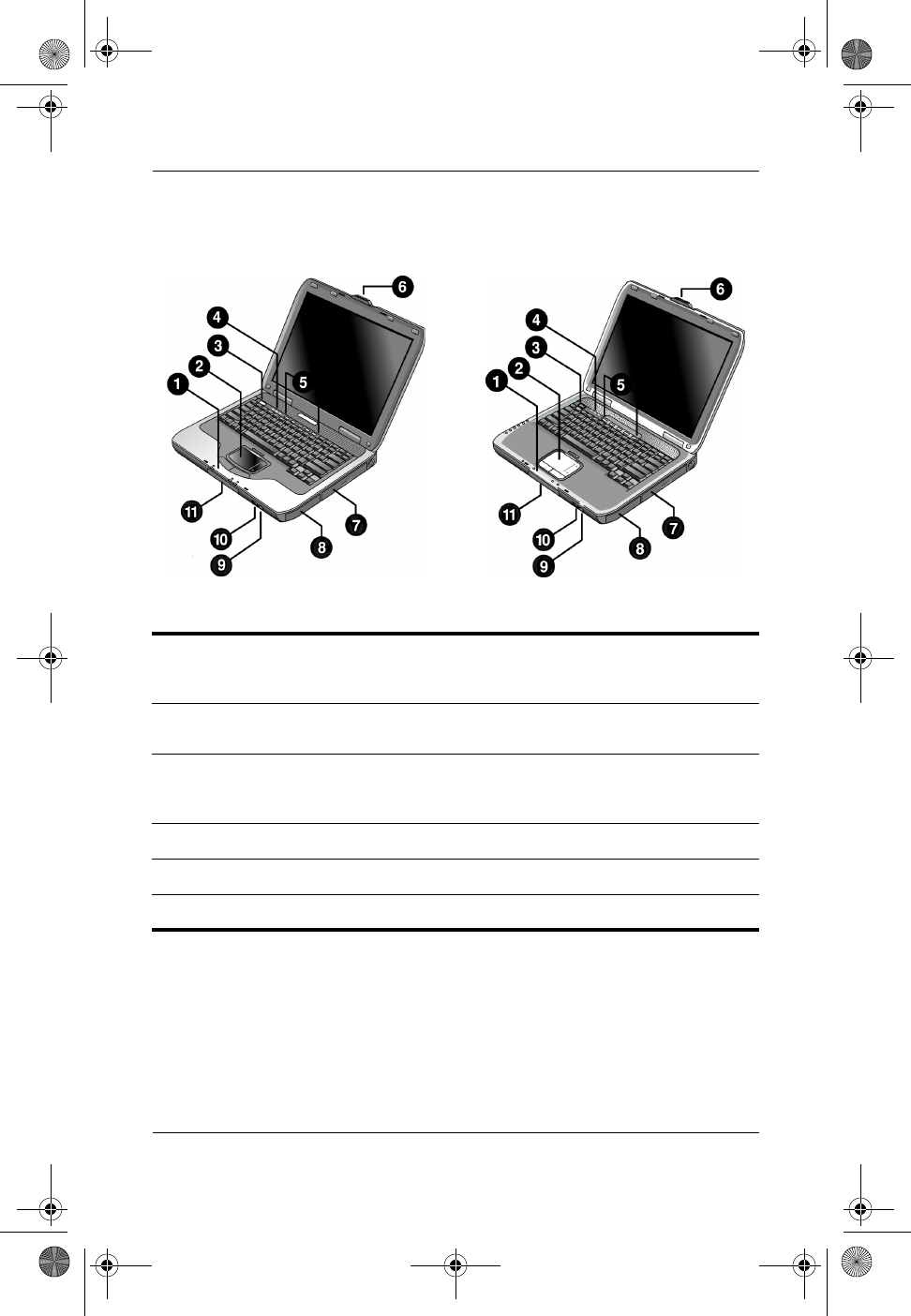
Getting Started with Your Notebook
Startup Guide 1–3
Front Panel and Right Panel Components
1Main status lights (left to right):
power mode, hard drive activity,
and battery
7CD-ROM, DVD, or other drive
2TouchPad, scroll pad, Click
buttons, and an on-off button
8Battery pack
3Power button: turns the notebook
on and off
9Wireless on-off button and
indicator light (select
models only)
4Keyboard status lights -Infrared port (select models only)
5One-Touch buttons qHard drive
6Notebook open/close latch
HP_SU_370699-001.book Page 3 Thursday, May 13, 2004 4:39 PM
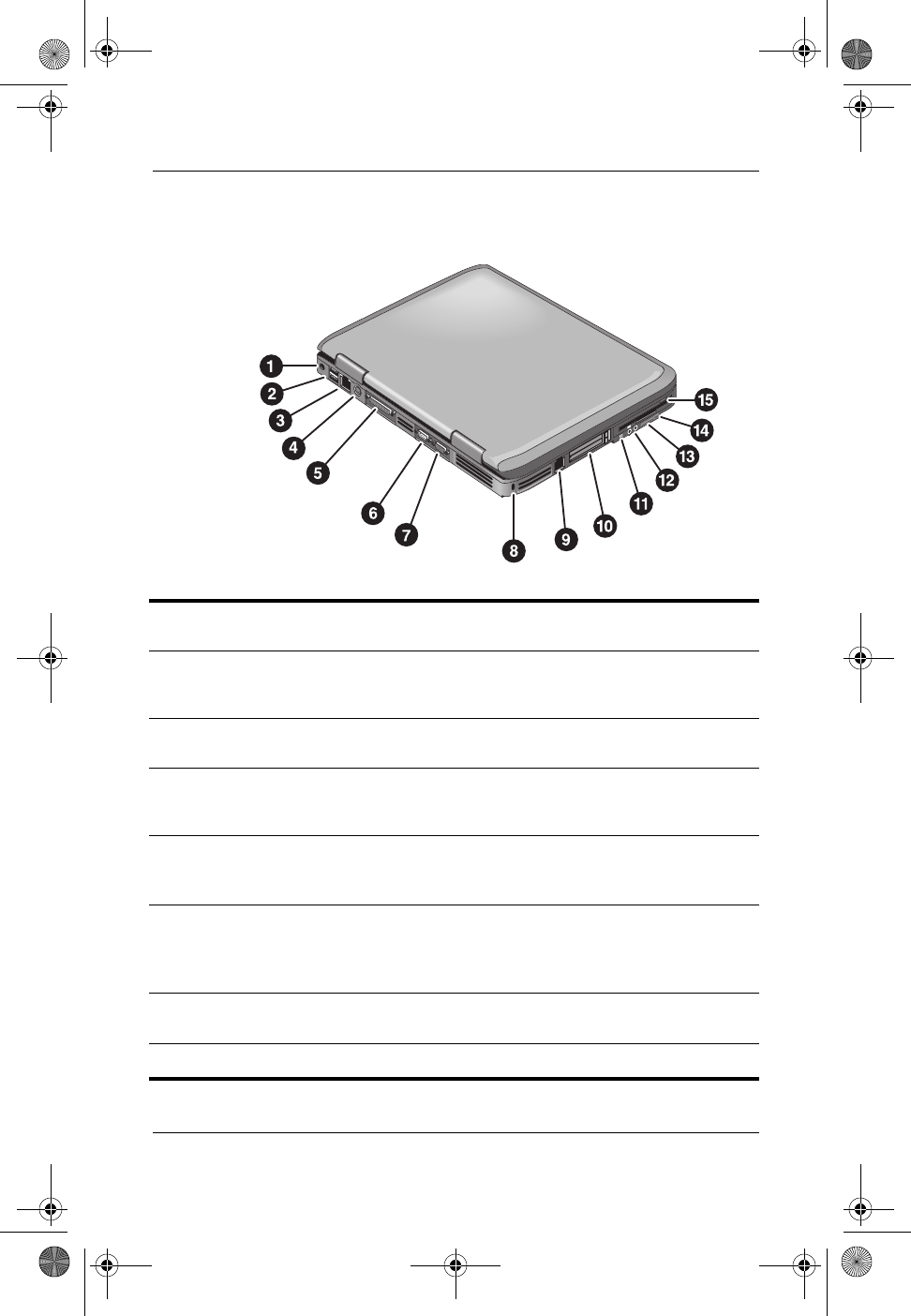
1–4 Startup Guide
Getting Started with Your Notebook
Left Panel and Back Panel Components
1AC adapter jack 9RJ-11 jack: connects the
modem cable
2Universal serial bus (USB) ports -PC Card and CardBus slot and
button (select models only;
location varies by model)
3RJ-45 jack: connects a network
cable qIEEE 1394 port
(select models only)
4S-Video out jack
(select models only) wAudio jacks (left to right):
external microphone, audio out
(headphones)
5Parallel port (LPT1): use this port
for a parallel printer or other
parallel device (select models only)
eVolume control
6Serial port (COM1): use this port
for a serial mouse, modem, printer,
or other serial device
(select models only)
rAudio mute button and audio
mute light
7External monitor port tDiskette drive
(select models only)
8Cable lock slot (security connector)
HP_SU_370699-001.book Page 4 Thursday, May 13, 2004 4:39 PM
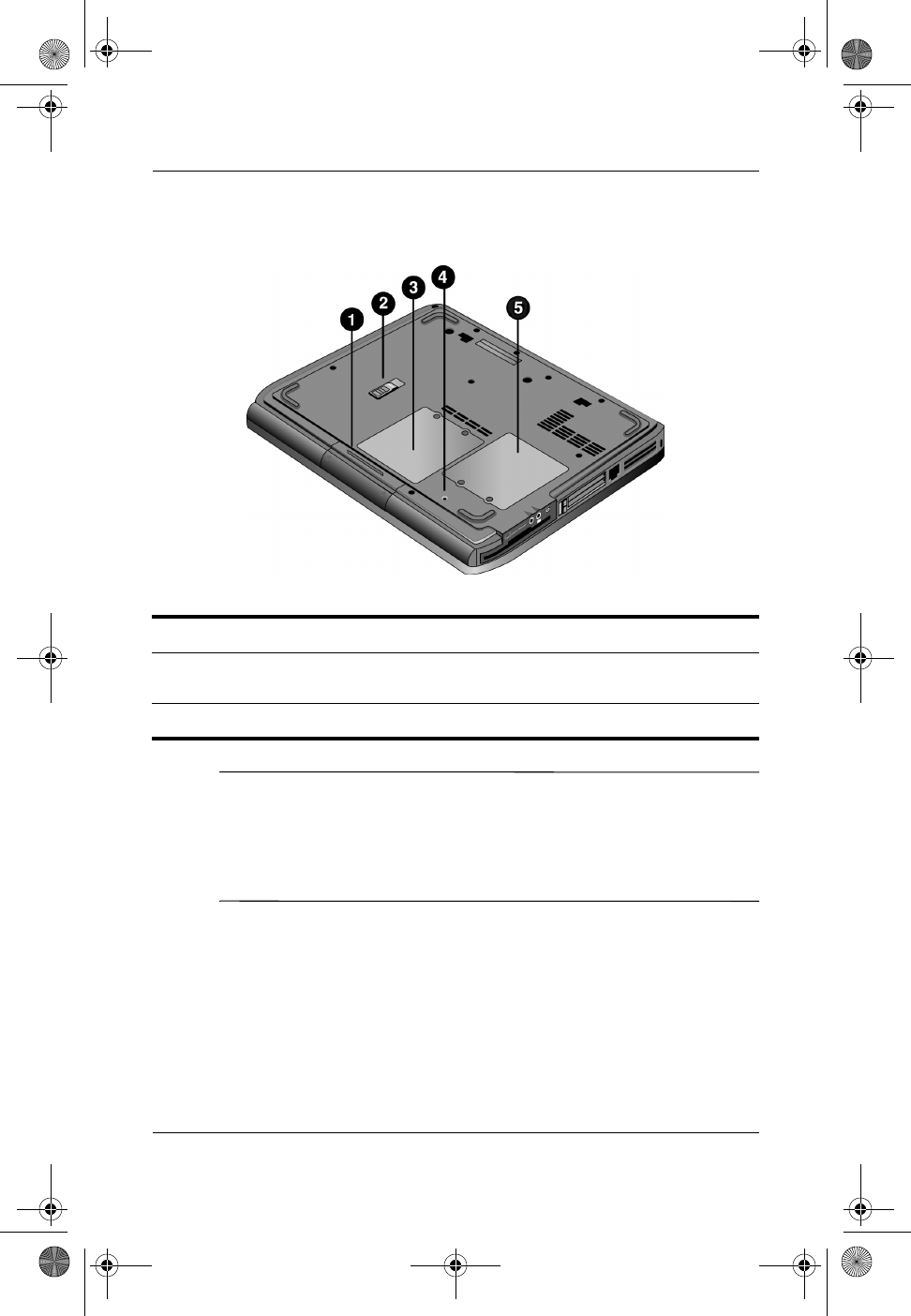
Getting Started with Your Notebook
Startup Guide 1–5
Bottom Panel Components
ÄCAUTION: To prevent an unresponsive system and the display of a
warning message, install only a Mini PCI device authorized for use in
your notebook by the governmental agency that regulates wireless
devices in your country. If you install a device and then receive a
warning message, remove the device to restore notebook functionality.
Then contact Customer Care.
1Hard drive 4Reset button
2Battery latch 5Mini PCI cover
(no user parts inside)
3RAM (memory) cover
HP_SU_370699-001.book Page 5 Thursday, May 13, 2004 4:39 PM
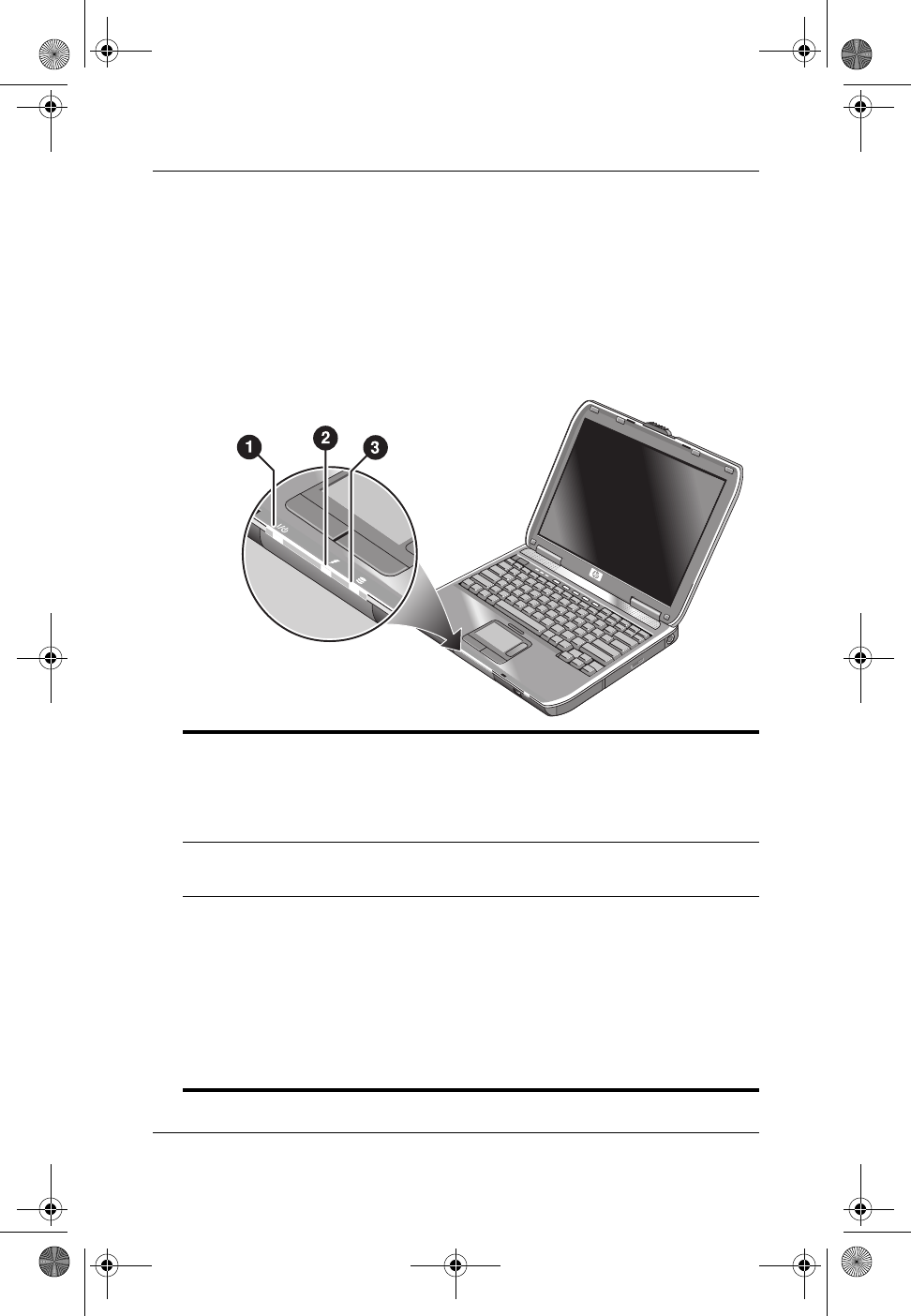
1–6 Startup Guide
Getting Started with Your Notebook
Status Lights
The notebook includes a number of status lights that report power
and battery status, drive activity, and keyboard functions such as
Caps Lock and Num Lock.
The following diagram shows the main status lights on the front
of the notebook.
1Power mode
■On—notebook is on (even if the display is off)
■Blinking—notebook is in Standby
■Off—notebook is off or in Hibernation
2Hard drive activity
On—notebook is accessing the hard drive
3Battery status
■Green—AC adapter is connected and the battery pack is fully
charged
■Amber—AC adapter is connected and the battery pack is
charging
■Blinking—AC adapter is connected and the battery pack is
missing or has a fault
■Off—AC adapter is not connected
HP_SU_370699-001.book Page 6 Thursday, May 13, 2004 4:39 PM
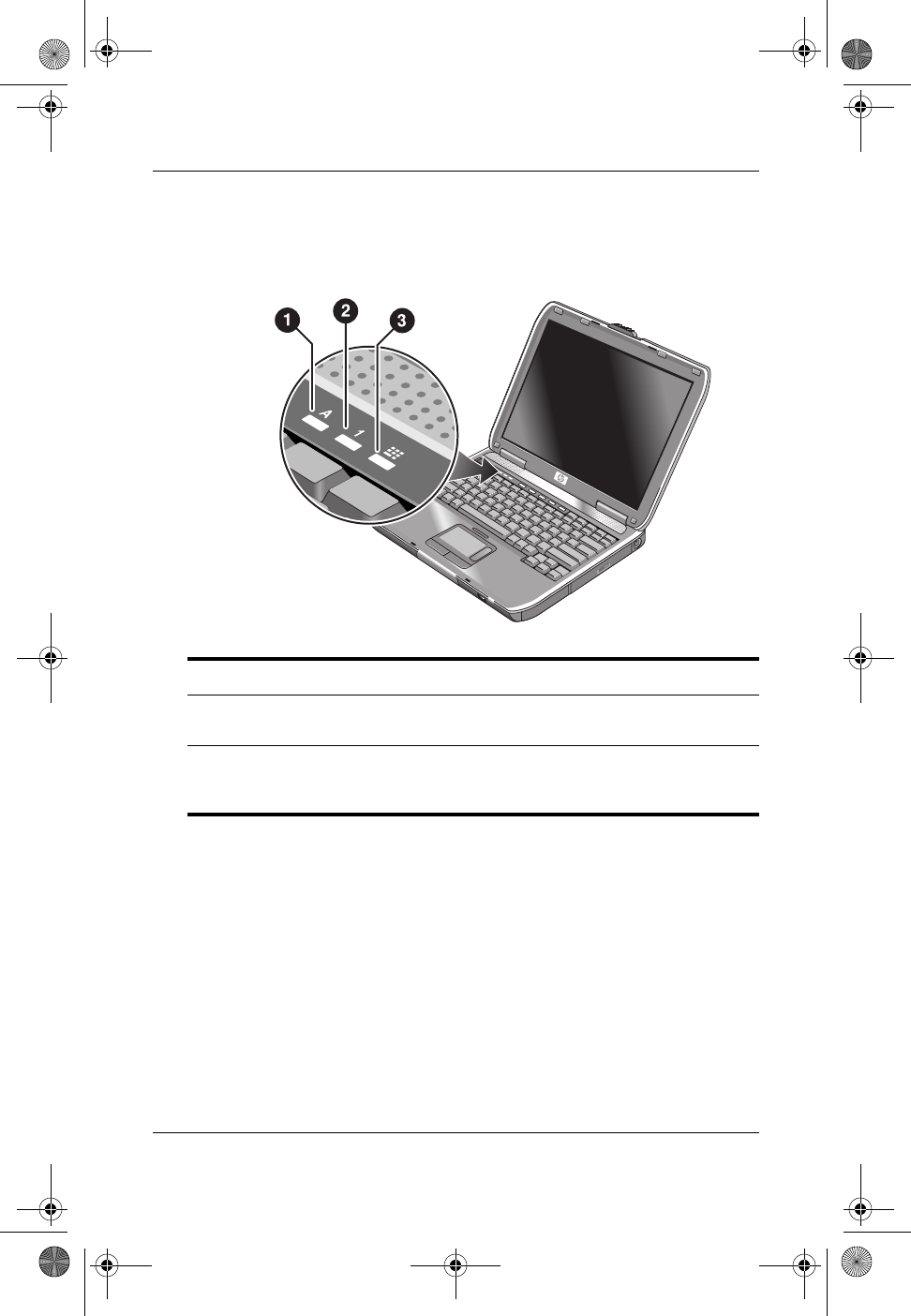
Getting Started with Your Notebook
Startup Guide 1–7
The keyboard status lights, located above the keyboard, indicate
the states of the keyboard locks.
1Caps Lock On: Caps Lock is active.
2Num Lock On: Num Lock is active. (The Keypad Lock must also be
on to use the embedded keypad.)
3Keypad Lock On: The embedded keypad is active (Fn+F8). Num
Lock must also be on for the numeric keys. Otherwise, cursor control
is active (as marked on an external keyboard).
HP_SU_370699-001.book Page 7 Thursday, May 13, 2004 4:39 PM
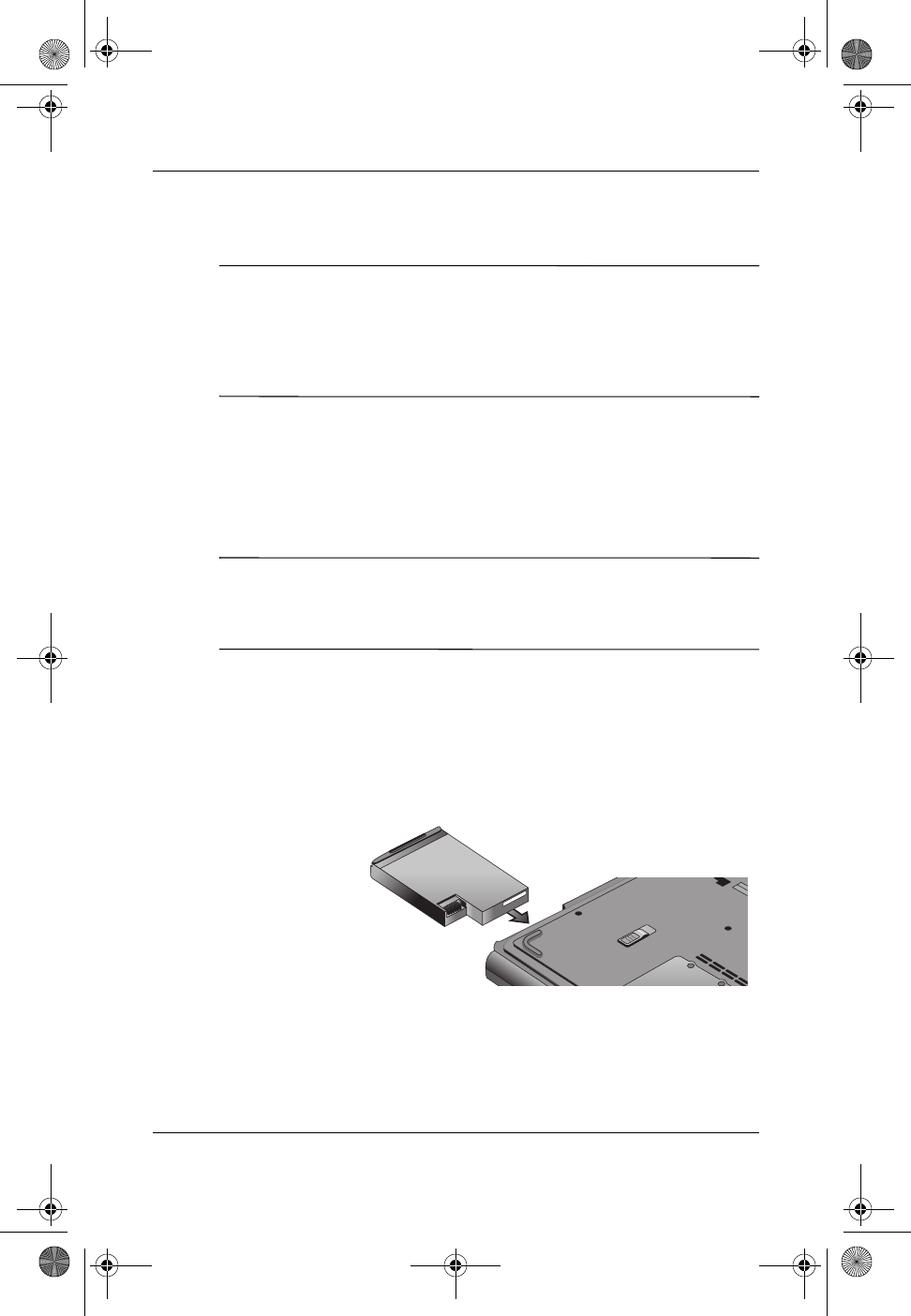
1–8 Startup Guide
Getting Started with Your Notebook
Setting Up Your Notebook
ÅWARNING: To reduce the risk of serious injury, read the Safety &
Comfort Guide. It describes proper workstation setup, posture, and
health and work habits for computer users, and provides important
electrical and mechanical safety information. This guide is located on
the Web at http://www.hp.com/ergo and on the hard drive or on the
Documentation CD that is included with the product.
When you set up your notebook for the first time, you will
connect the AC adapter, charge the battery pack, turn on the
notebook, and run the Microsoft® Windows® Setup program.
Step 1: Insert the Battery Pack
ÅWARNING: Do not mutilate or puncture battery packs. Do not dispose
of battery packs in fire, or they can burst or explode, releasing
hazardous chemicals. Rechargeable battery packs must be recycled or
disposed of properly.
To install the battery pack:
1. Turn the notebook upside down.
2. Insert the connector end of the battery pack into the battery
pack compartment, then slide the battery pack in until it
latches.
HP_SU_370699-001.book Page 8 Thursday, May 13, 2004 4:39 PM
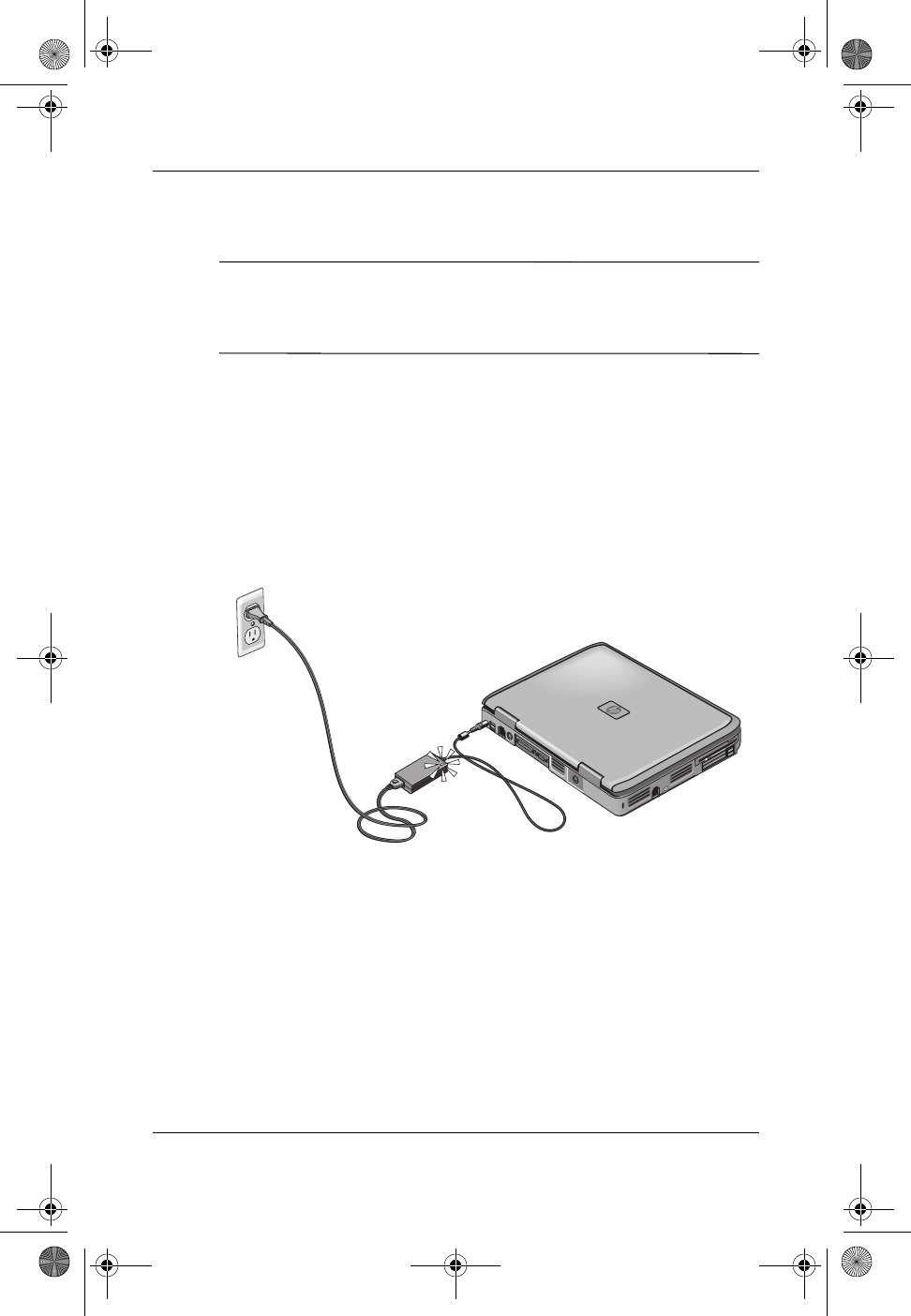
Getting Started with Your Notebook
Startup Guide 1–9
Step 2: Connect AC Power
ÄCAUTION: Use only the AC adapter included with your notebook (or
other approved adapter that meets the power requirements of the
notebook). Using the wrong AC adapter could damage the notebook
or adapter, cause data loss, and may void your warranty.
1. Plug the AC adapter into the notebook.
2. Connect the power cord to the AC adapter.
3. Plug the power cord into a wall outlet. The notebook battery
starts charging.
✎When unplugging the power cord, unplug it from the outlet
before unplugging it from the AC adapter.
While the battery pack is charging, you can continue with the
section “Step 3: Connect a Phone Line.”
HP_SU_370699-001.book Page 9 Thursday, May 13, 2004 4:39 PM
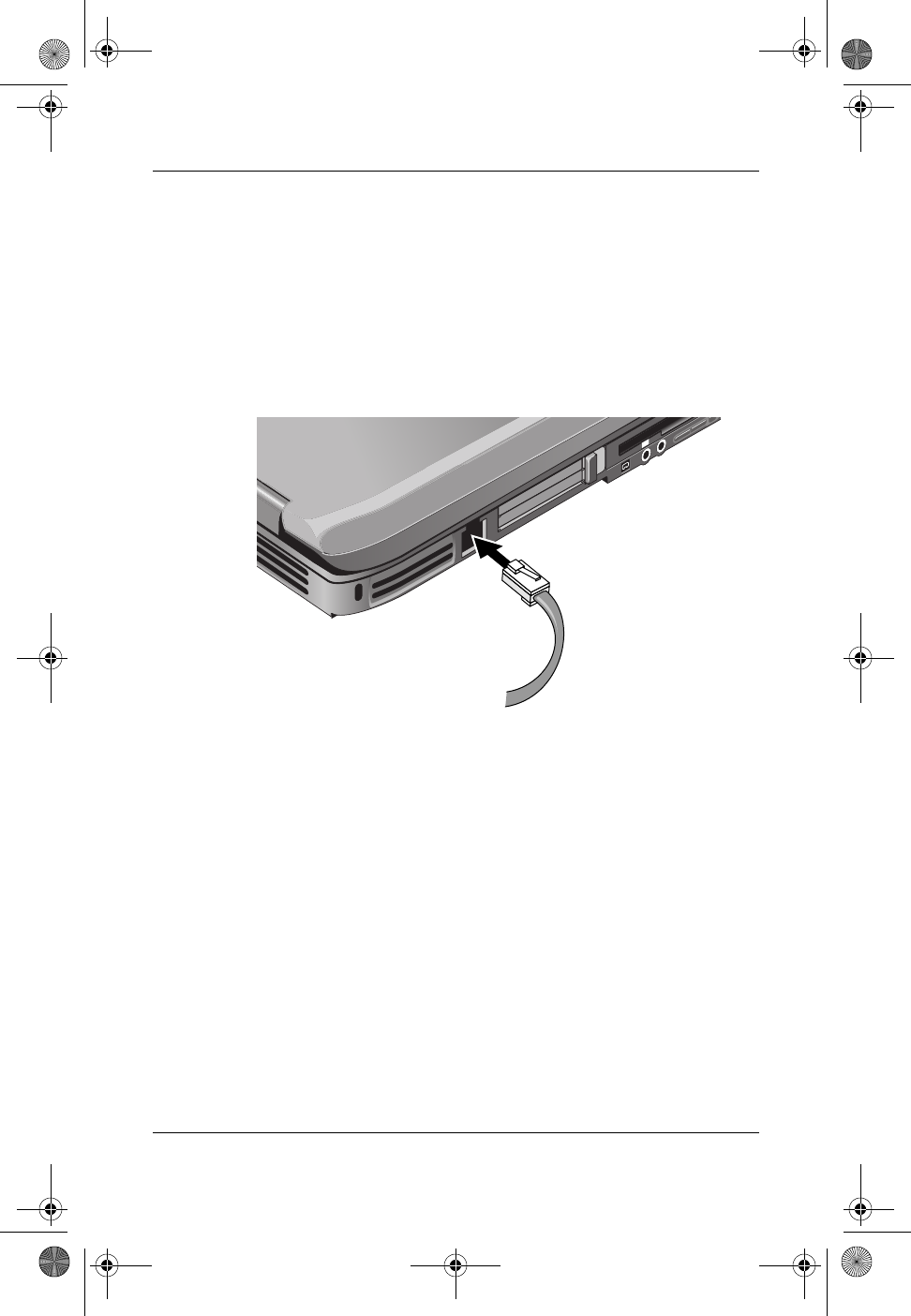
1–10 Startup Guide
Getting Started with Your Notebook
Step 3: Connect a Phone Line
1. Make sure the telephone line is an analog line, sometimes
called a data line. (Do not use a digital line.)
2. Connect the telephone cord (RJ-11) into a telephone jack.
3. Plug the other end of the telephone cord into the RJ-11
modem jack on the notebook.
For details about using the modem, including AT commands, see
the Documentation CD included with your notebook.
HP_SU_370699-001.book Page 10 Thursday, May 13, 2004 4:39 PM
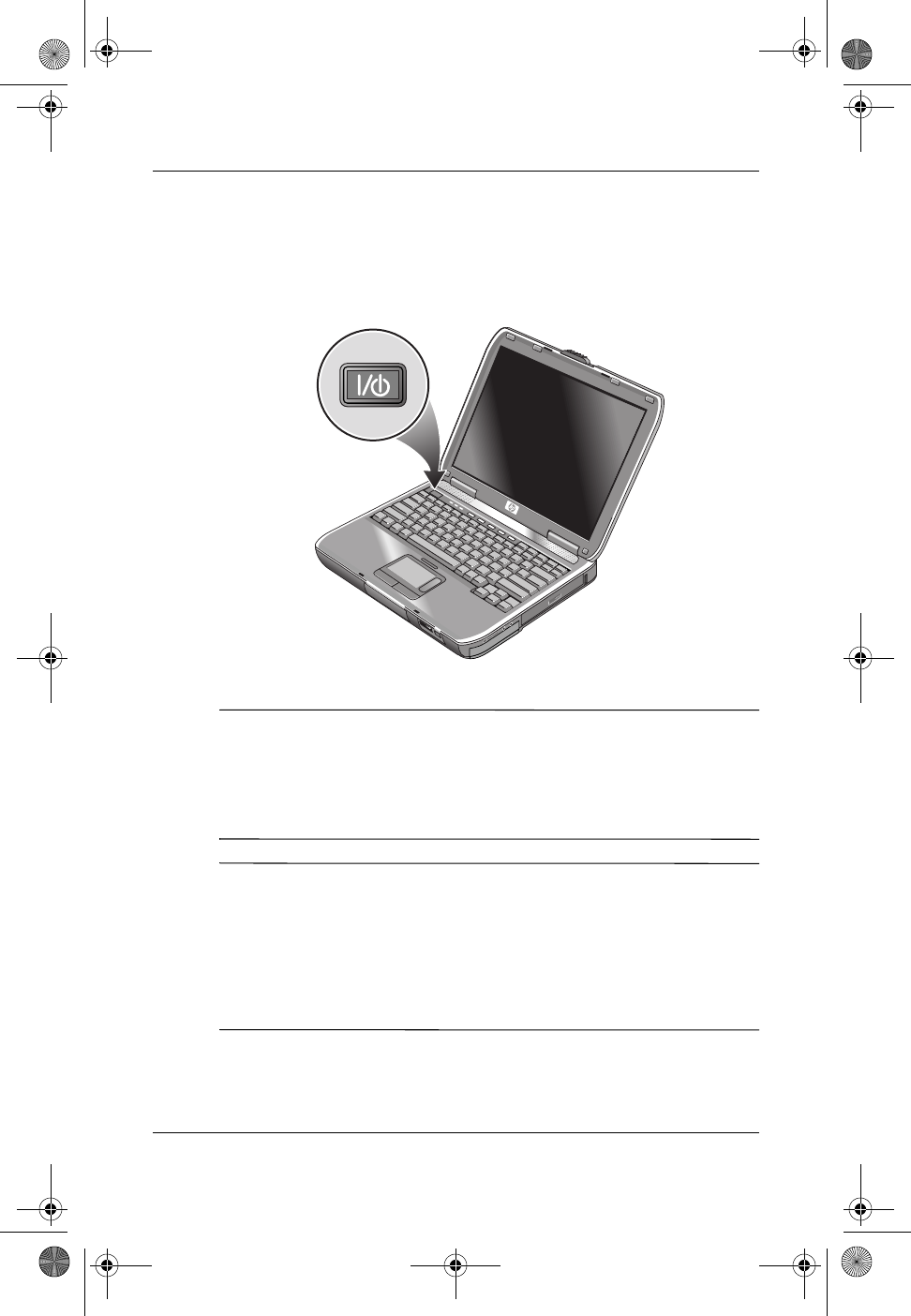
Getting Started with Your Notebook
Startup Guide 1–11
Step 4: Turn On the Notebook
Press the power button above the left side of the keyboard. The
notebook boots up, and Windows starts automatically.
✎If your notebook does not turn on when operating on
battery power, the battery pack may be out of power. Plug in
the AC adapter, then press the power button again. Leave the
AC adapter plugged in for several hours to fully charge
the battery pack. Charge times will vary.
ÅWARNING: This notebook is designed to run demanding applications
at full power. As a result of increased power consumption, it is normal
for the notebook to feel warm or hot when used continuously. To avoid
potential discomfort or burns, do not block the air vents or use the
notebook on your lap for extended periods. The notebook complies
with the user-accessible surface temperature limits defined by the
International Standard for Safety of Information Technology Equipment
(IEC 60950).
HP_SU_370699-001.book Page 11 Thursday, May 13, 2004 4:39 PM
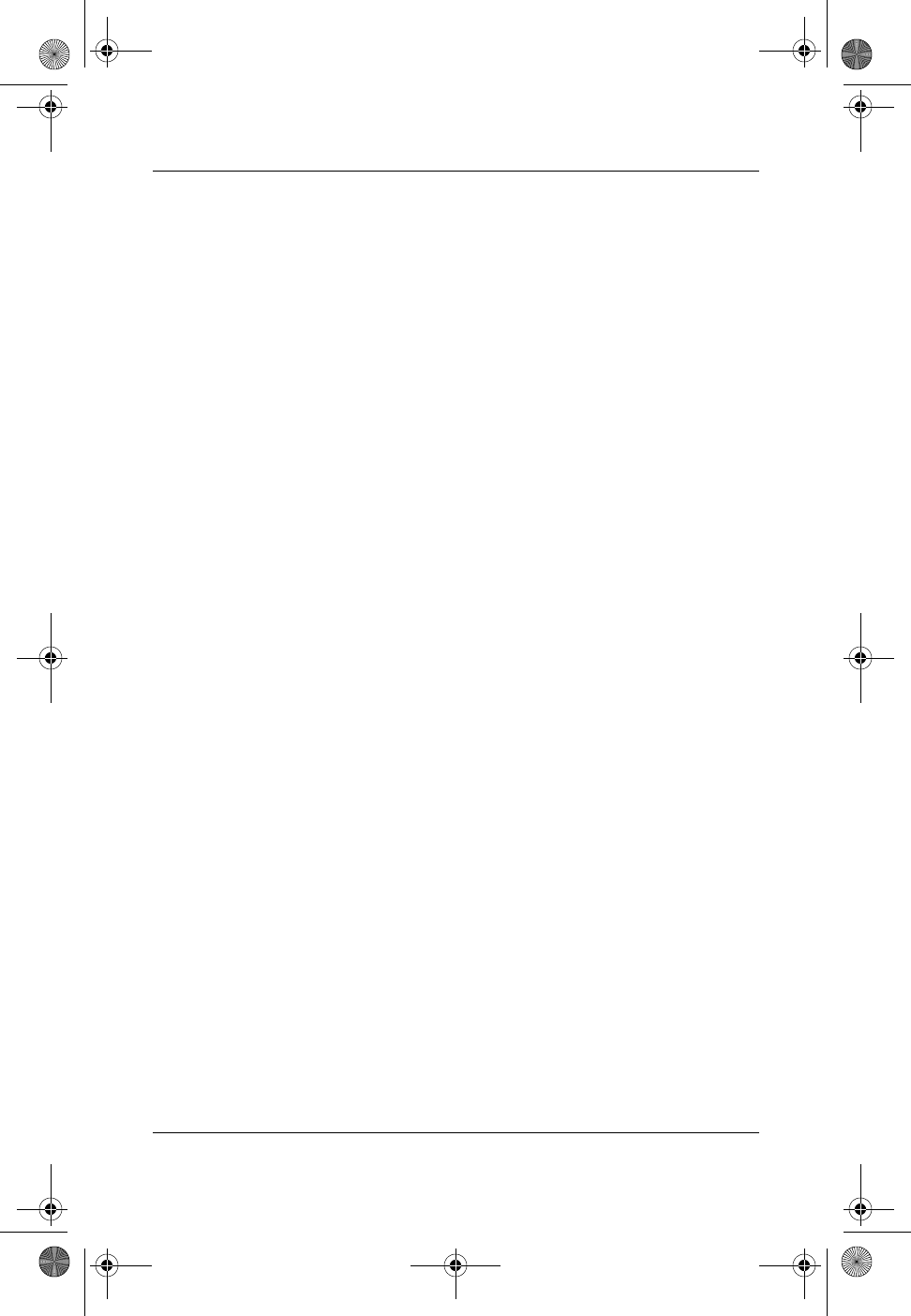
1–12 Startup Guide
Getting Started with Your Notebook
Step 5: Set Up Windows
Your notebook has the Microsoft Windows operating system
preinstalled on its hard drive. The first time you turn on your
notebook, the Windows Setup program runs automatically and
includes opportunities to customize your setup.
1. Follow the Setup program instructions on the screen. If the
program prompts you to enter the Product ID code, locate
the code on the bottom of the notebook.
2. Check the modem country or region settings. Select Start >
Control Panel > Printers and Other Hardware > Phone and
Modem Options, then choose your country/region.
Using the Documentation CD
Information about using the notebook can be found on the
Documentation CD included with the notebook. To view a guide:
1. Insert the Documentation CD into a CD or DVD drive. If
autorun is enabled, the reference library menu is displayed on
the screen (this may take a few seconds).
2. Select the guide you want to read from the reference
library menu.
3. If prompted, accept the Adobe® Acrobat® Reader license
agreement or install Acrobat Reader by following the
instructions on the screen.
HP_SU_370699-001.book Page 12 Thursday, May 13, 2004 4:39 PM
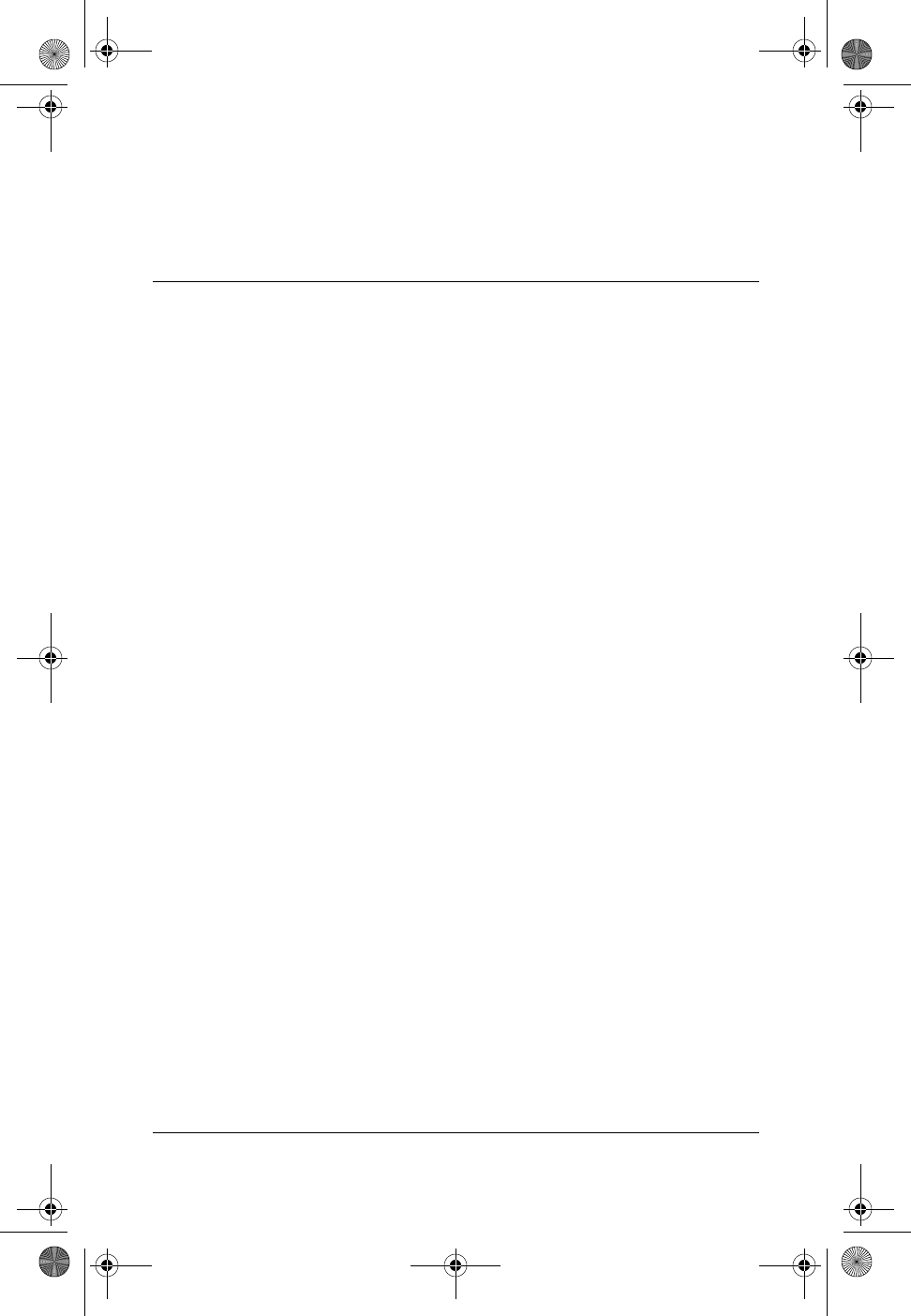
Startup Guide 2–1
2
Basic Operation
Operating Your Notebook
You can start and stop your notebook by using the power button.
At other times, power considerations, types of active connections,
and startup time may cause you to use alternative methods to start
or stop your notebook. This chapter describes several methods.
HP_SU_370699-001.book Page 1 Thursday, May 13, 2004 4:39 PM
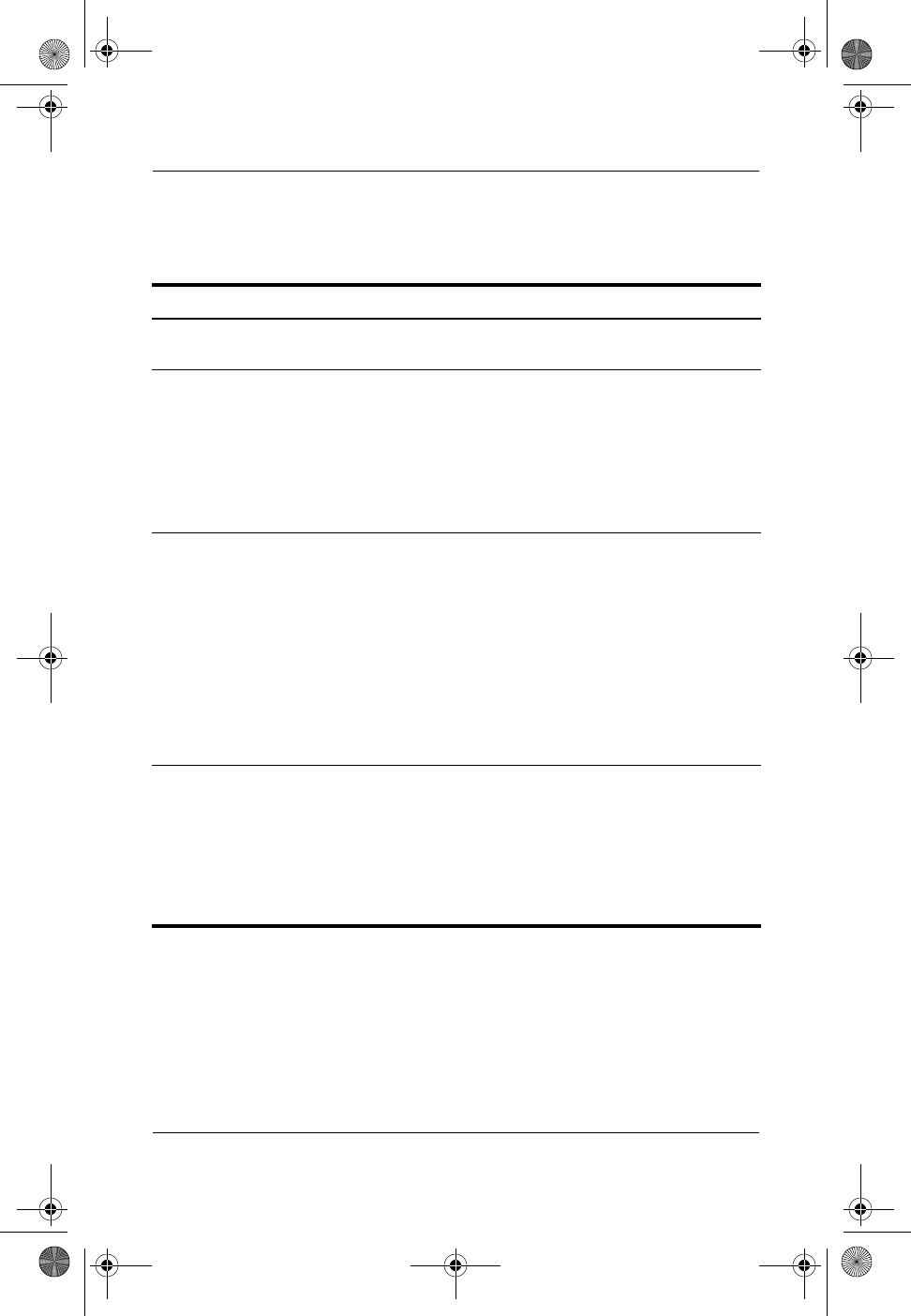
2–2 Startup Guide
Basic Operation
Default Power Settings
You can also customize how these power modes work. See the
“Battery Packs and Power Management” chapter in the Reference
Guide on the Documentation CD included with your notebook.
Power mode To enter this mode Function
ON—Power status
light will turn on. Briefly press the power
button. Powers on the notebook.
OFF—Power status
light will turn off. Select Start > Turn Off
Computer > Turn Off. If the
system has stopped
responding and Windows
shutdown procedures cannot
be used, press and hold the
power button for 4 seconds to
turn off the notebook.
Powers off the notebook.
Standby—Power
status light will blink. Select Start > Turn Off
Computer > Stand By.
-or-
Allow the system to time out.
■Saves significant
power.
■Turns off the display
and other
components.
■Maintains current
session in RAM.
■Restarts quickly.
■Restores network
connections.
Hibernation—Power
status light will
turn off.
If the notebook is already on,
briefly press the power
button.
-or-
Press Fn+F12.
-or-
Allow the system to time out.
■Saves maximum
power.
■Saves current
session to disk, then
shuts down.
■Restores network
connections.
HP_SU_370699-001.book Page 2 Thursday, May 13, 2004 4:39 PM
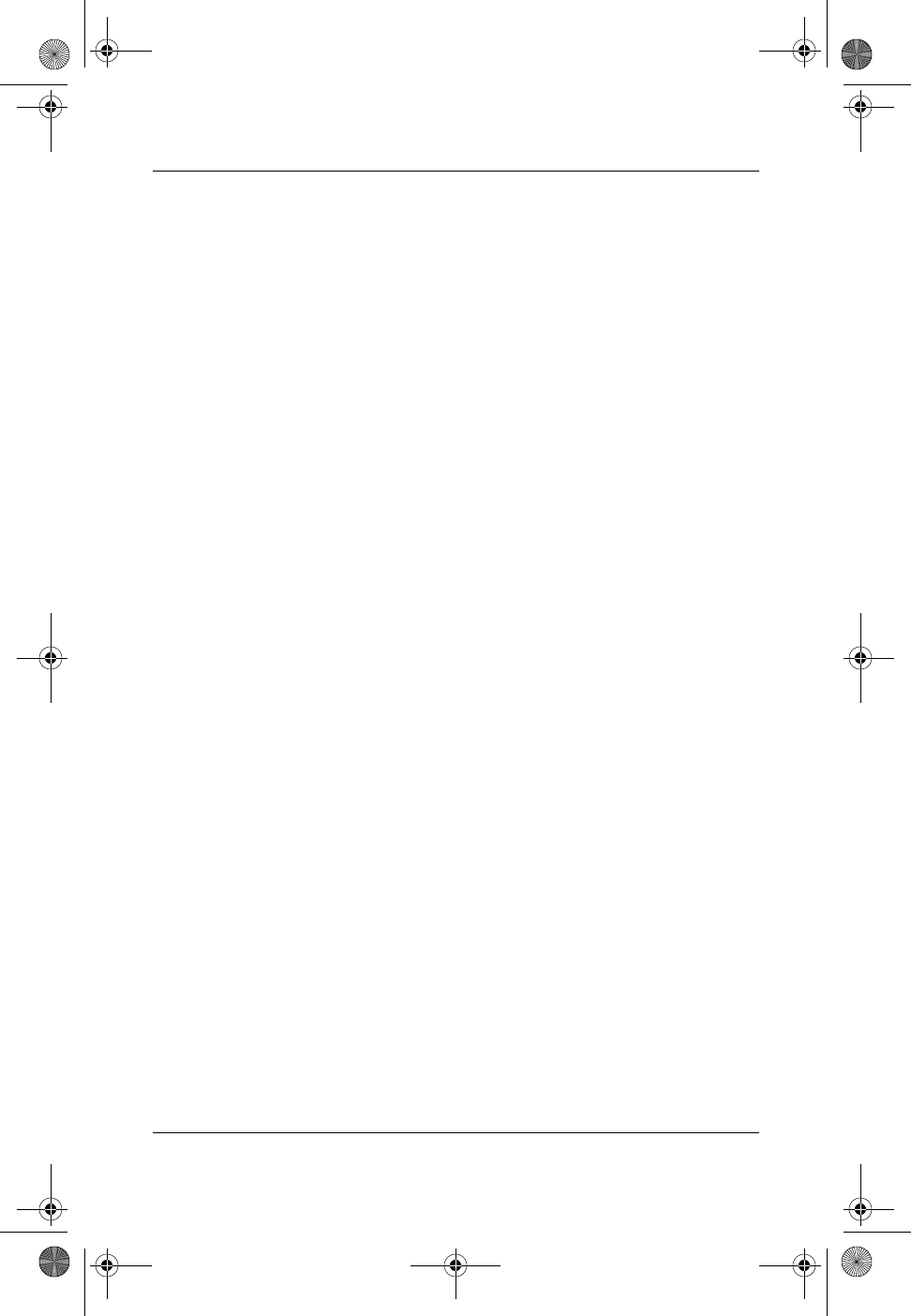
Basic Operation
Startup Guide 2–3
To Reset the Notebook
Occasionally, you may find that Windows or the notebook has
stopped responding and will not let you turn off the notebook. If
this happens, try the following procedures in this order:
■If possible, shut down Windows. Press ctrl+alt+del, then select
Shut Down > Restart.
-or-
■Press the power button for at least 4 seconds until the display
shuts down. Unsaved data will be lost. Press the power button
again to restart.
-or-
■Insert the tip of a paper clip into the reset button on the
bottom of the notebook, then press the power button to
restart.
To Change the Boot Device
The notebook normally boots from its internal hard drive. You
can also boot the notebook from a diskette drive, a CD-ROM
drive, or an internal network interface card.
1. Select Start > Turn Off Computer > Restart.
2. When the logo screen appears, press esc to display the
Boot menu.
3. Use the arrow keys to select the boot device, then press enter.
If you want to boot from a specific device whenever it is present,
change the boot order using the BIOS Setup utility. See
“Configuring Your Notebook” in the “Troubleshooting” chapter
in this guide.
HP_SU_370699-001.book Page 3 Thursday, May 13, 2004 4:39 PM
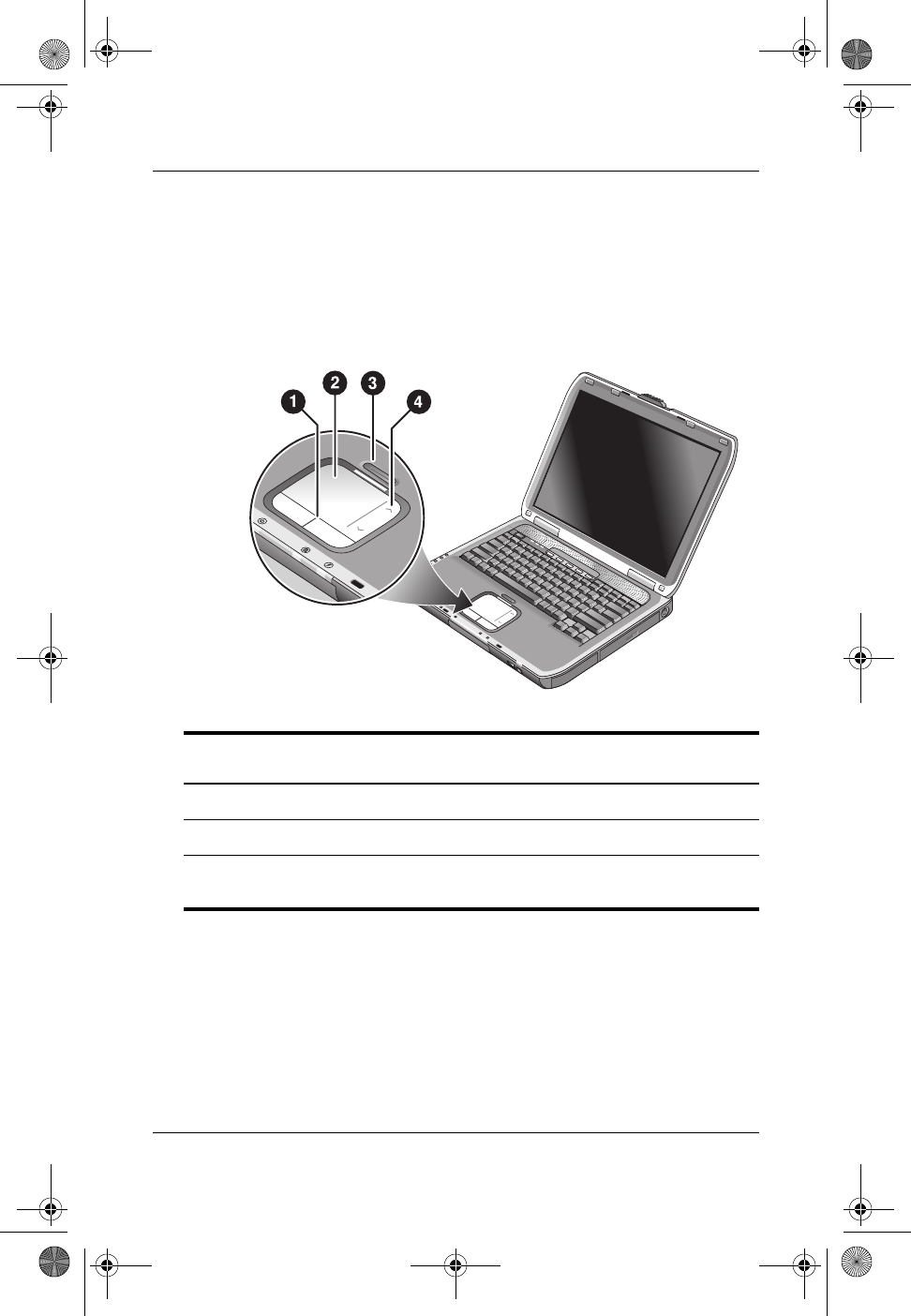
2–4 Startup Guide
Basic Operation
To Use the TouchPad
The TouchPad includes an on-off button so you can turn off the
TouchPad to avoid moving the pointer accidentally when you are
typing. The indicator light turns off when you turn off the
TouchPad.
1Click buttons. The Click buttons work like the left and right buttons on
a standard mouse
2TouchPad (touch-sensitive pointing device).
3TouchPad on-off button and indicator light.
4Scroll pad. The scroll pad scrolls vertically to display
the contents of the active window.
HP_SU_370699-001.book Page 4 Thursday, May 13, 2004 4:39 PM
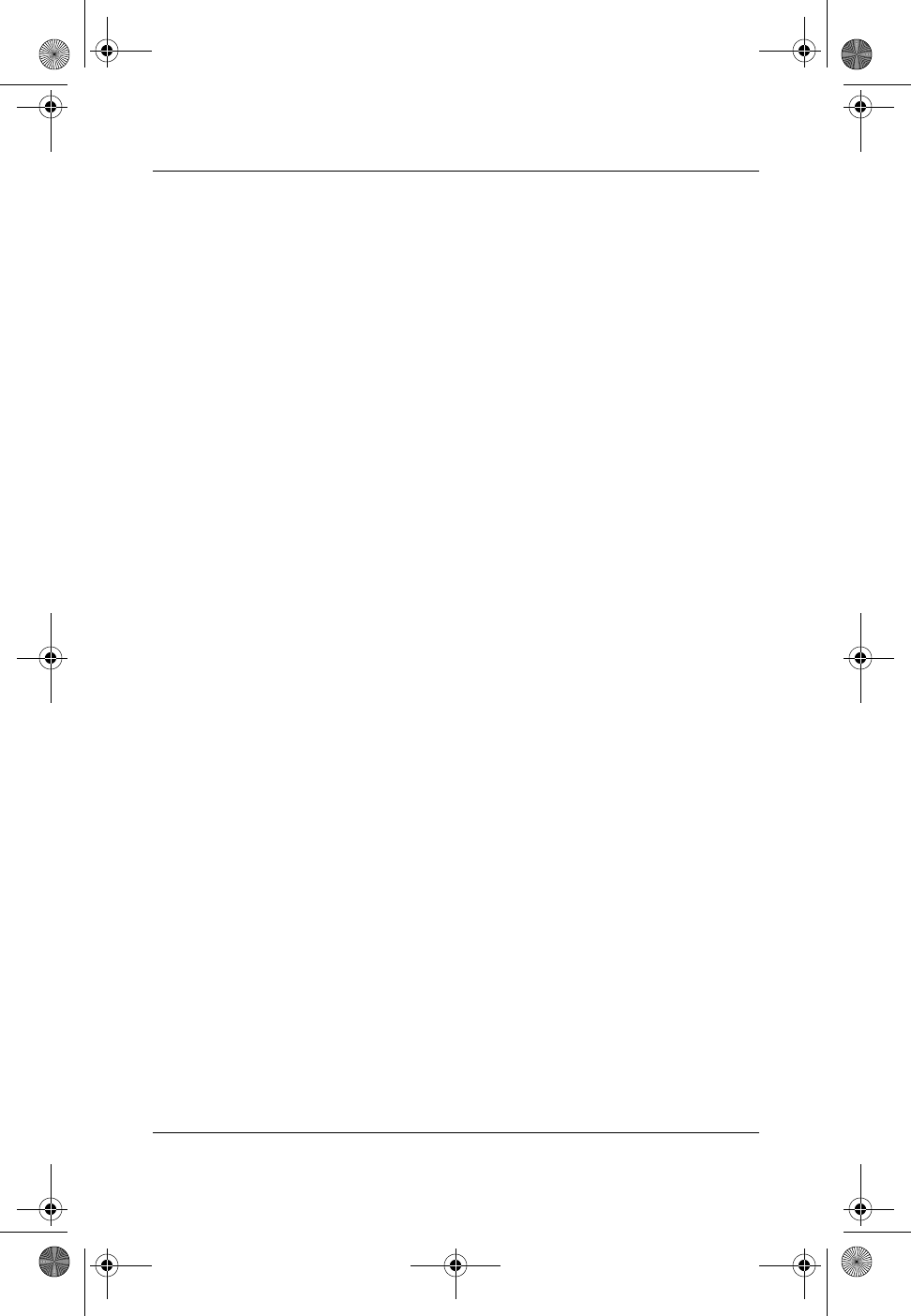
Basic Operation
Startup Guide 2–5
To Use the Tap to Click Function of the
TouchPad
The Tap to Click function of your TouchPad is enabled by default.
To disable it, follow the instructions included here:
1. Select Start > Control Panel > Printers and Other Hardware >
Mouse. The Mouse Properties dialog box opens.
2. Select the Tapping tab.
3. In the left panel, clear the Tapping check box.
4. Select Apply > OK.
The Tap to Click function is now disabled.
HP_SU_370699-001.book Page 5 Thursday, May 13, 2004 4:39 PM
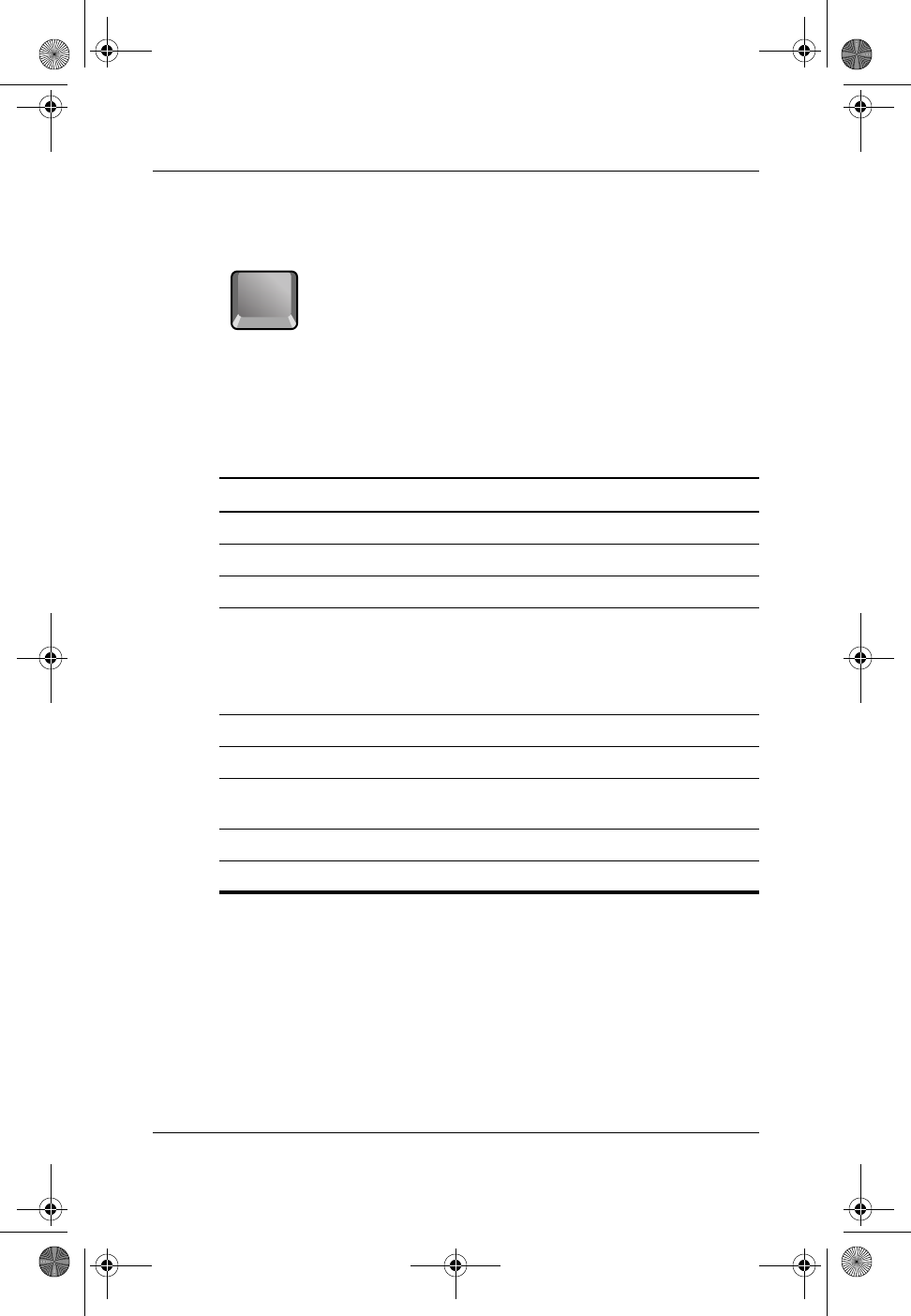
2–6 Startup Guide
Basic Operation
To Use the Function Hot Keys
The combination of the Fn key plus another key creates a hot
key—a shortcut key sequence—for various system controls. To
use a hot key, press and hold Fn, press the appropriate second key,
then release both keys.
This hot key Does this
Fn+F1 Decreases the display brightness.
Fn+F2 Increases the display brightness.
Fn+F5 Toggles the external monitor on and off.
Fn+F8 Toggles the built-in keypad on and off. Does
not affect an external keyboard. If Num Lock
is on, then the numeric functions are active;
otherwise, cursor control is active (as marked
on an external keyboard).
Fn+F12 Initiates Hibernation.
Fn+NumLock Toggles Scroll Lock on and off.
Fn+Page Up Increases the audio volume and cancels the
mute setting.
Fn+Page Down Decreases the audio volume.
Fn+Backspace Mutes/unmutes the audio output.
Fn
HP_SU_370699-001.book Page 6 Thursday, May 13, 2004 4:39 PM
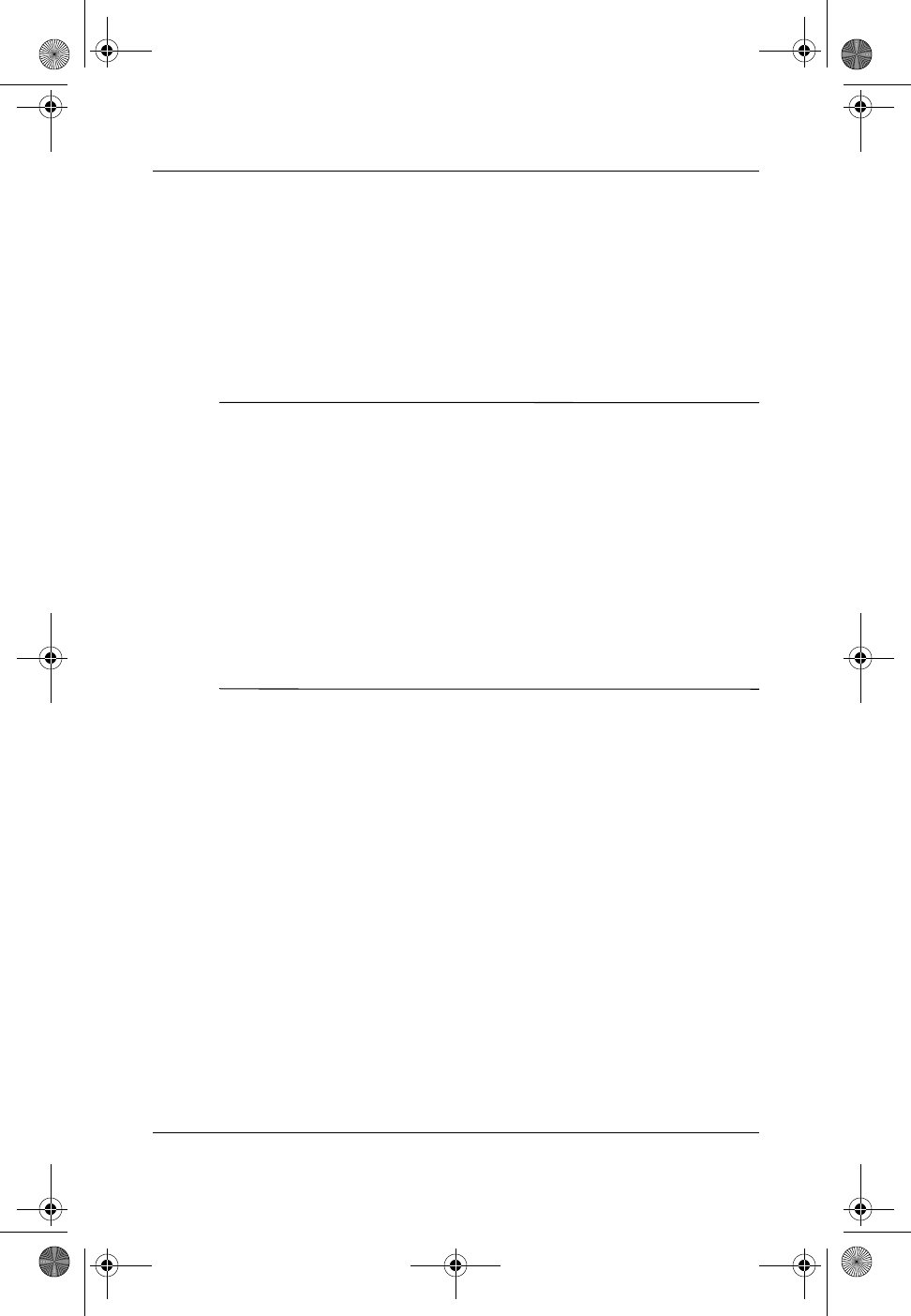
Basic Operation
Startup Guide 2–7
Using CDs or DVDs
To Play DVD Movies
If your notebook is equipped with a DVD or other DVD readable
drive, it also includes DVD player software that lets you play
DVD movies.
✎DVDs can have regional codes embedded in the disc data. These
codes prevent DVD movies from being played outside the region
of the world in which they are sold. If you get a region code error,
you are trying to play a DVD intended for a different region.
Most DVD drives let you change the region code only a limited
number of times (usually no more than 4). When you reach this
limit, your last change to the region code will be hard-coded on
the DVD drive and will be permanent. Your warranty does not
cover the expense of correcting this situation. Refer to the
Help for your DVD player software for details about setting
region codes.
To Write to DVD Media (Select Models Only)
If your notebook is equipped with a DVD+RW/R and CD-RW
Combo Drive, you must install your DVD burning software from
the CDs included with your notebook before you can write to
DVD media.
When writing to DVD+R or DVD+RW media, observe the
following guidelines:
■Place the notebook on a flat, stable surface.
■Ensure that the AC adapter is connected to the notebook and
an AC electrical outlet.
■Close and exit all other software applications, except the CD
burning software (when writing a data disc) or DVD burning
software (when writing a video disc).
HP_SU_370699-001.book Page 7 Thursday, May 13, 2004 4:39 PM
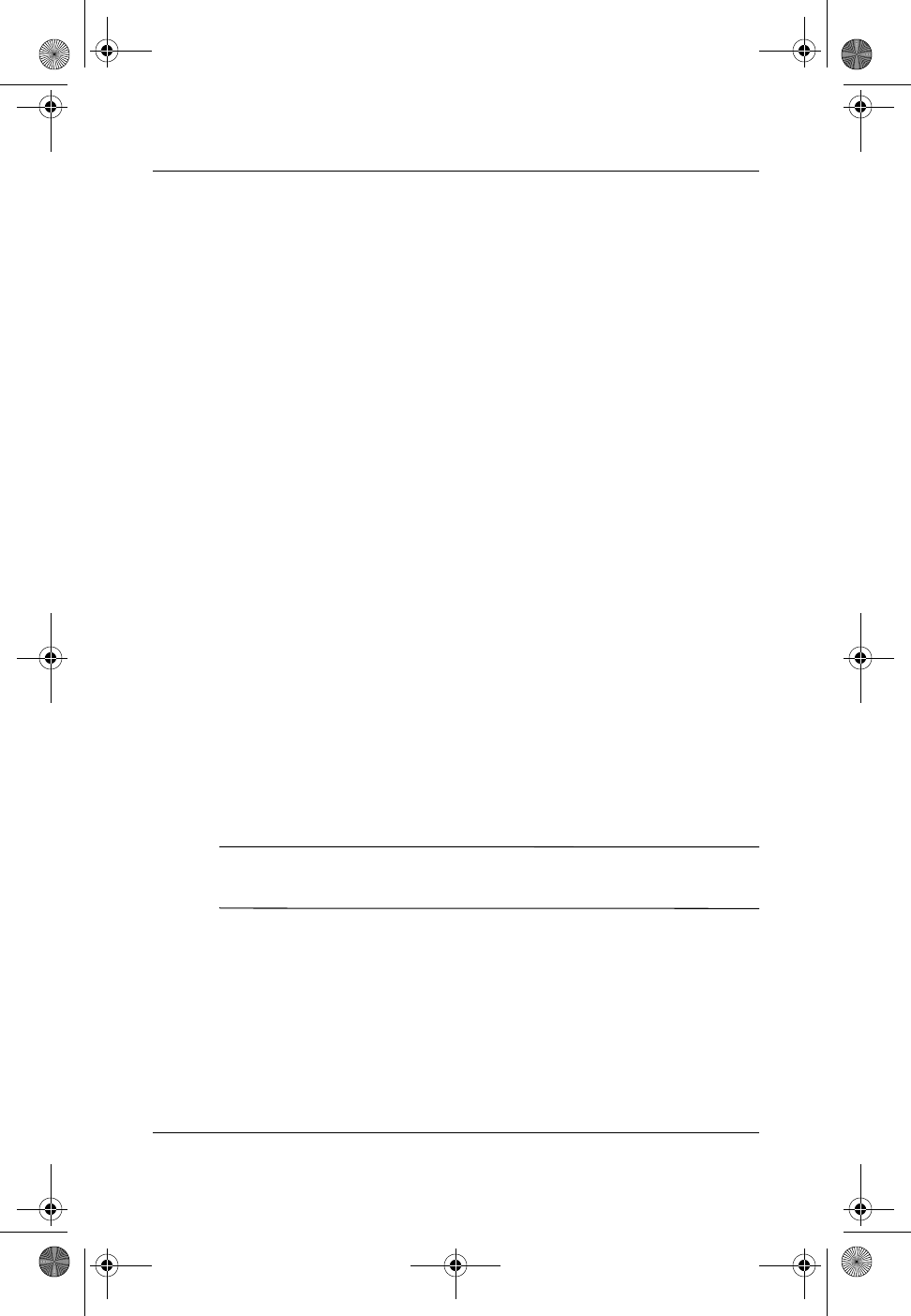
2–8 Startup Guide
Basic Operation
To Connect a TV to Your Notebook
(Select Models Only)
You can use a TV as an external monitor for your notebook. To
connect a TV to your notebook:
1. Plug a standard 4-pin S-Video cable to the S-Video out jack
on your notebook (yellow connector on the back panel). Plug
the other end of the cable to the S-Video in jack on your
television.
✎Although your notebook has a 7-pin S-Video out jack, the
notebook accepts either a 7-pin or 4-pin cable connection.
2. Select Start > Control Panel > Appearance and Themes >
Display. Then, select Settings tab > Advanced button >
Display tab.
3. To enable the TV, select the red button next to TV.
✎If the S-Video cable is not plugged into your notebook and TV,
the red button will not be displayed.
4. Select Apply to accept the changes.
5. If you are prompted to restart Windows, select Yes.
To Connect an Infrared Device
(Select Models Only)
✎Select models include an infrared port. By default, the infrared
port is enabled, so you must first enable it before you can use it.
If your model has an infrared port (a small, rectangular lens
located on the front of the notebook), then your notebook can
communicate wirelessly with other infrared devices, such as
printers or other notebooks, using this port.
Basic Operation.fm Page 8 Thursday, May 27, 2004 12:34 PM
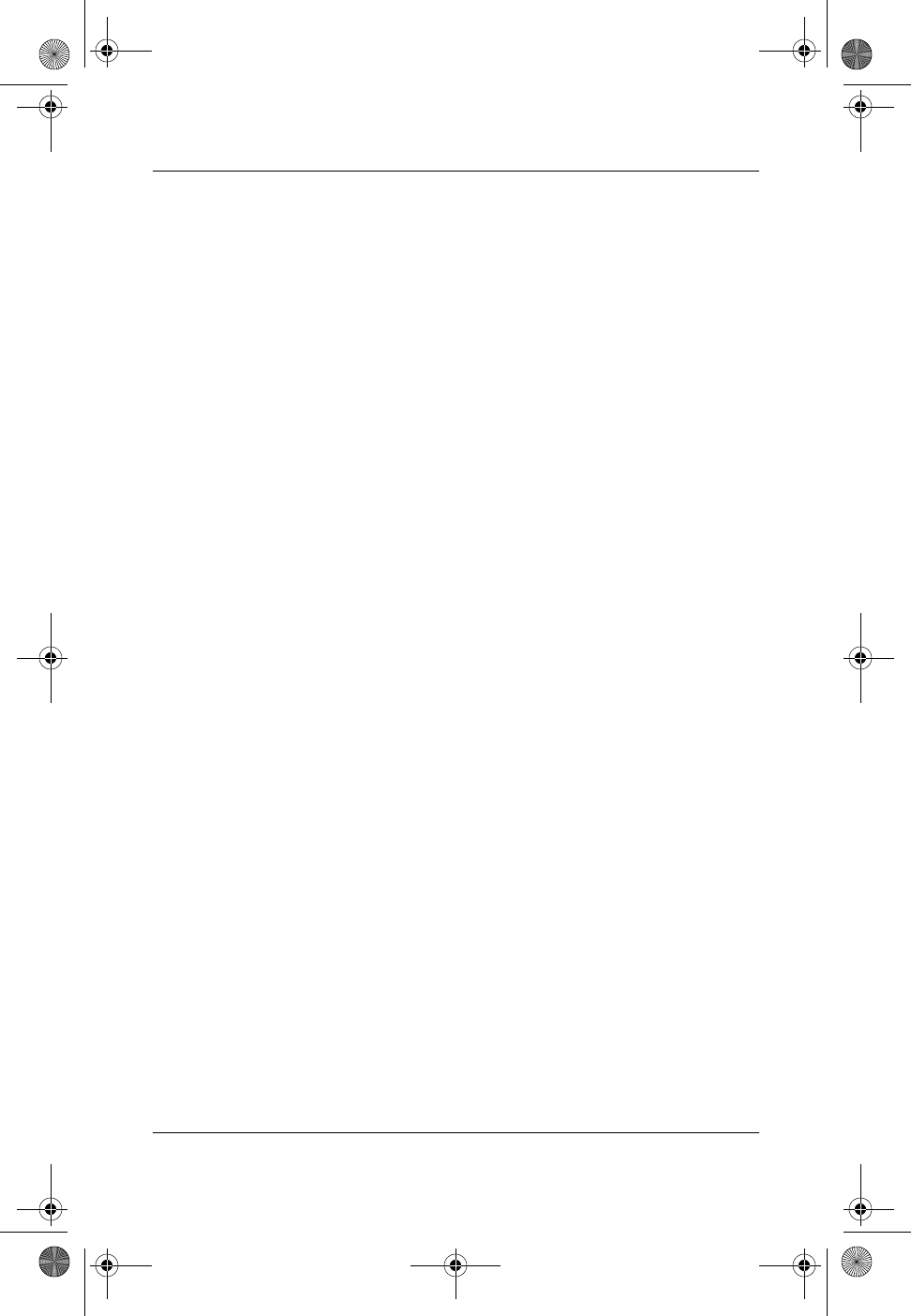
Basic Operation
Startup Guide 2–9
Using the Infrared Port
■Make sure the infrared port of your notebook and the infrared
port of the device with which you want to communicate lie in
a straight line facing each other. The 2 ports should be no
more than 3 feet (1 meter) apart with no obstructions in
between. Noise from nearby equipment can cause
transmission errors.
1. Select Start > Control Panel > Performance and
Maintenance > System.
2. Select the Hardware tab > Device Manager button > ALI
fast infrared controller > Enable Device button.
3. Select Next > Finish > Close. Then close all open dialog
boxes.
■To check the status of communications, open Wireless Link
by selecting Start > Control Panel > Printers & Other
Hardware > Wireless Link.
Printing to an Infrared Printer
Install your printer and assign it to the notebook infrared port.
You can then print from your applications or by following the
directions for infrared ports.
Transferring Files Through an Infrared Connection
You can use your notebook infrared port to transfer files by using
Wireless Link. See the Windows online Help for instructions on
using Wireless Link.
HP_SU_370699-001.book Page 9 Thursday, May 13, 2004 4:39 PM
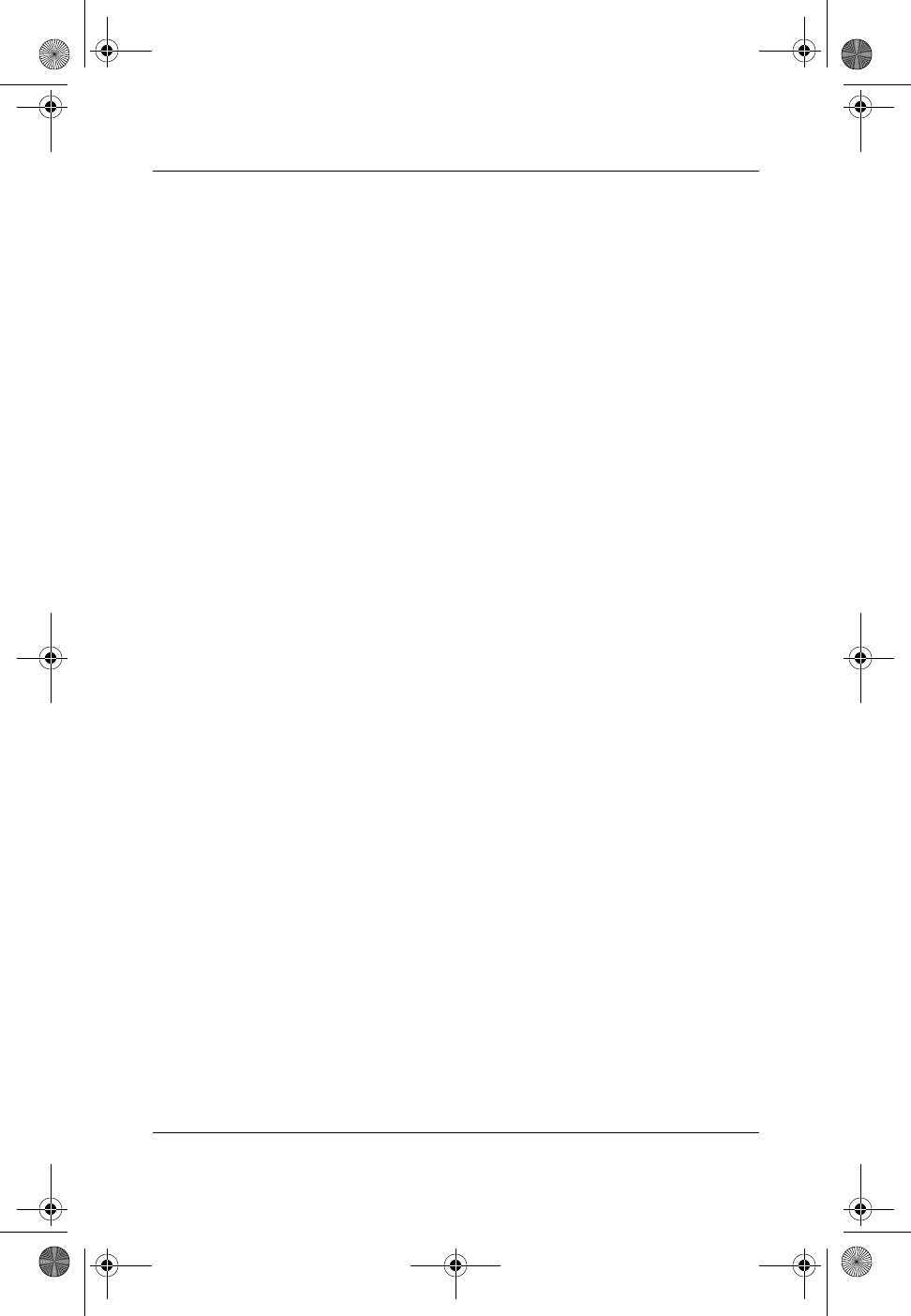
2–10 Startup Guide
Basic Operation
HP_SU_370699-001.book Page 10 Thursday, May 13, 2004 4:39 PM
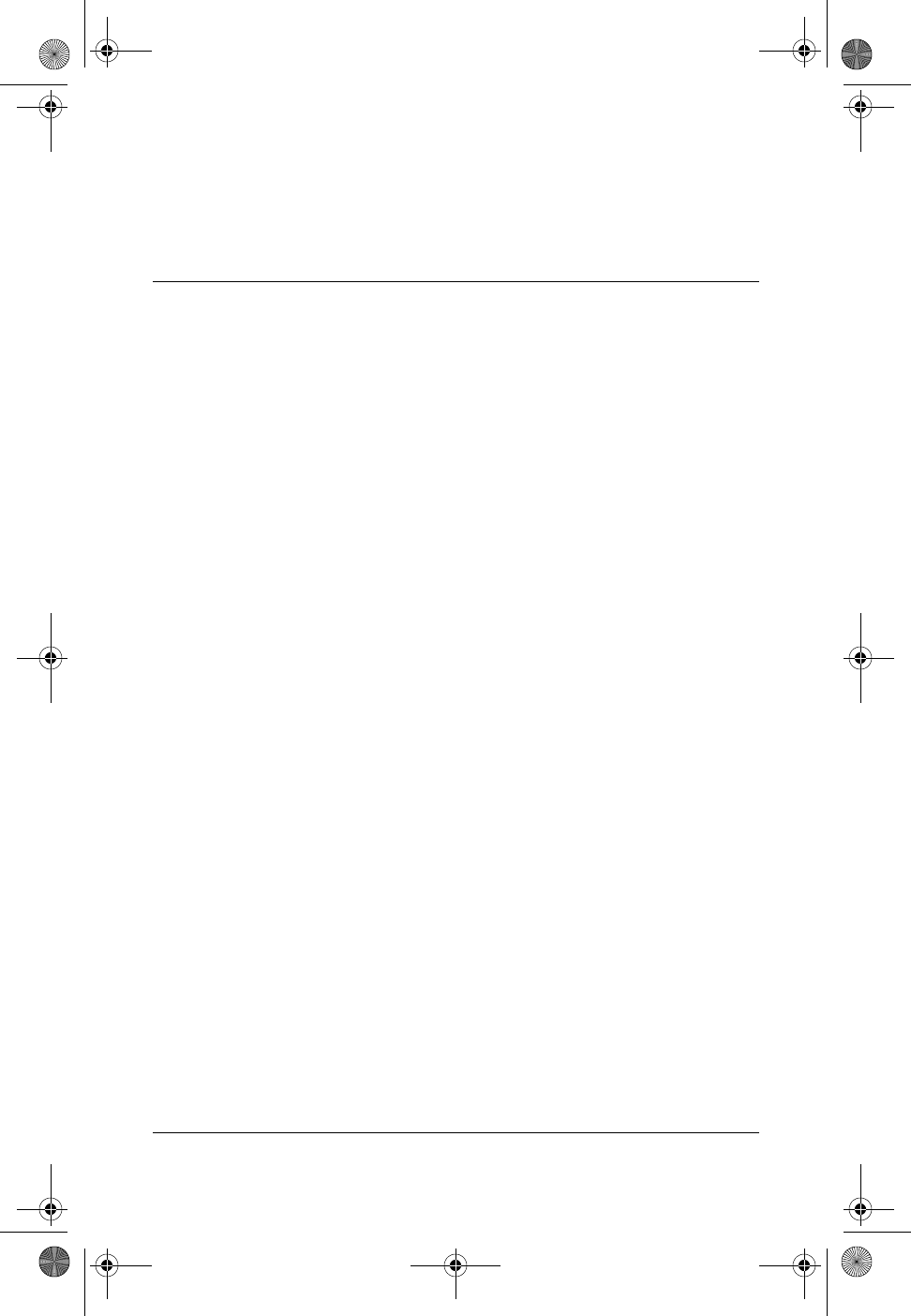
Startup Guide 3–1
3
Battery Packs and Power
Management
Using Battery Power
For information about how your notebook regulates power
consumption and how you can manually reduce power
consumption and extend the life of the notebook battery, see
the “Battery Packs and Power Management” chapter in the
Reference Guide on the Documentation CD included with your
notebook.
To Check Battery Status
From the battery status light
»Check the battery status light on the notebook.
From the Windows taskbar
The Windows taskbar can display a power icon that provides
detailed battery status information (see Windows Help for
details). The icon resembles a battery when a battery pack is the
notebook’s sole source of power.
■Place the pointer over the power icon to display the
remaining battery charge. This value is shown as either a
percentage of charge remaining or as time remaining.
■Select the power icon to open the Battery Meter window.
HP_SU_370699-001.book Page 1 Thursday, May 13, 2004 4:39 PM
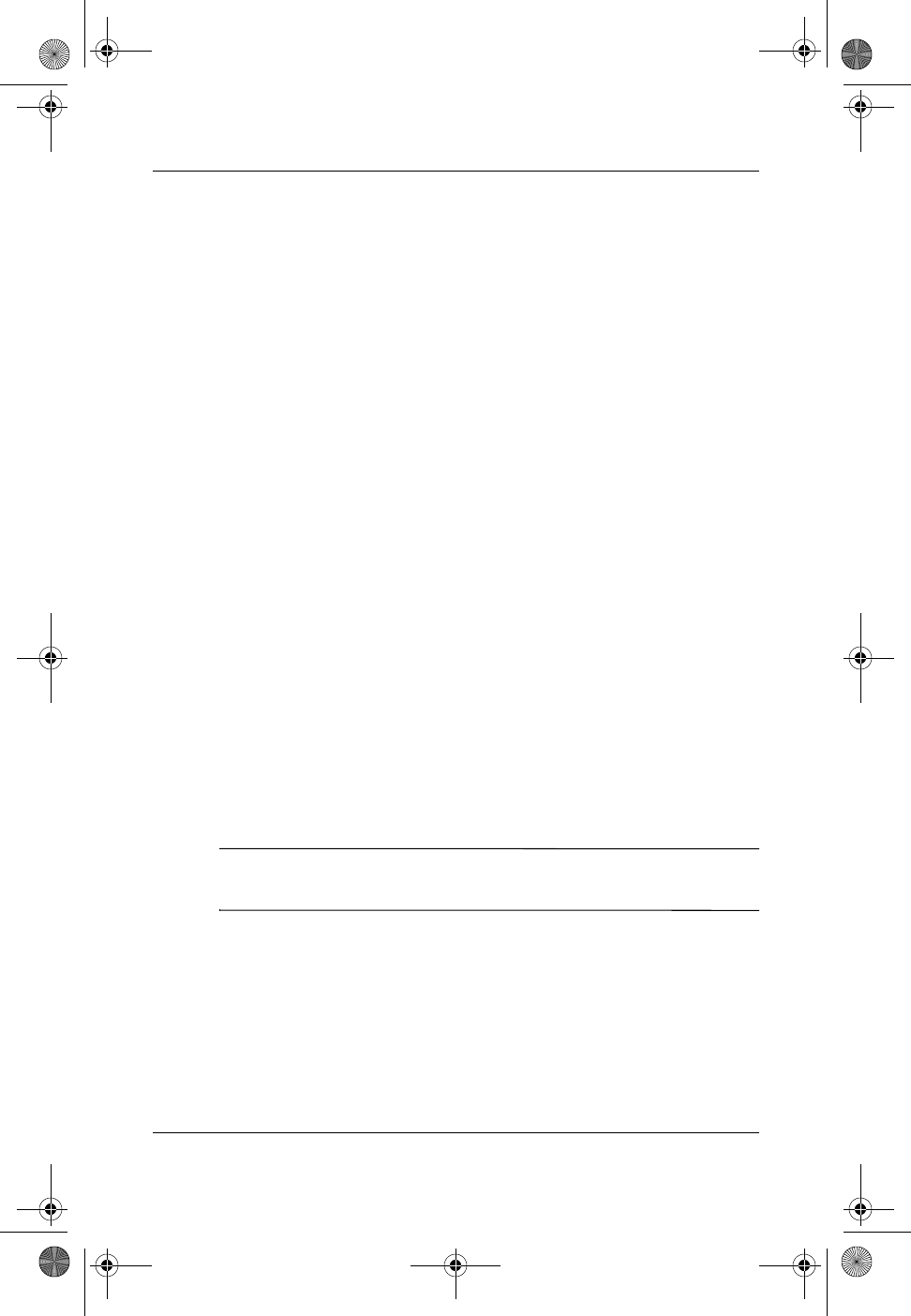
3–2 Startup Guide
Battery Packs and Power Management
From the Windows Control Panel
»Select Start > Control Panel > Performance and
Maintenance > Power Options, then select the Power Meter
tab to see the battery status. The Alarms and Advanced tabs
provide additional power information options.
On the battery pack
1. Remove the battery pack from the notebook. See the “Getting
Started with Your Notebook” chapter in this guide.
2. Press the contact pad on the side of the battery pack. The
number of lights that turn on indicates the remaining charge
(each light represents 20 percent of a full charge).
To Respond to a Low-Battery Warning
The notebook automatically alerts you when the battery power
drops to a critically low level. The notebook first emits a
high-pitched beep or displays a warning message. Then, if you
do not restore power within a short time, the notebook goes into
Hibernation.
After the notebook enters Hibernation in this way, you will not be
able to turn it on again until you restore power by doing one of the
following procedures:
■Replace the battery pack with a charged one.
■Plug in the AC adapter.
✎If you plug in the AC adapter, you can continue to work while
your battery pack recharges.
HP_SU_370699-001.book Page 2 Thursday, May 13, 2004 4:39 PM
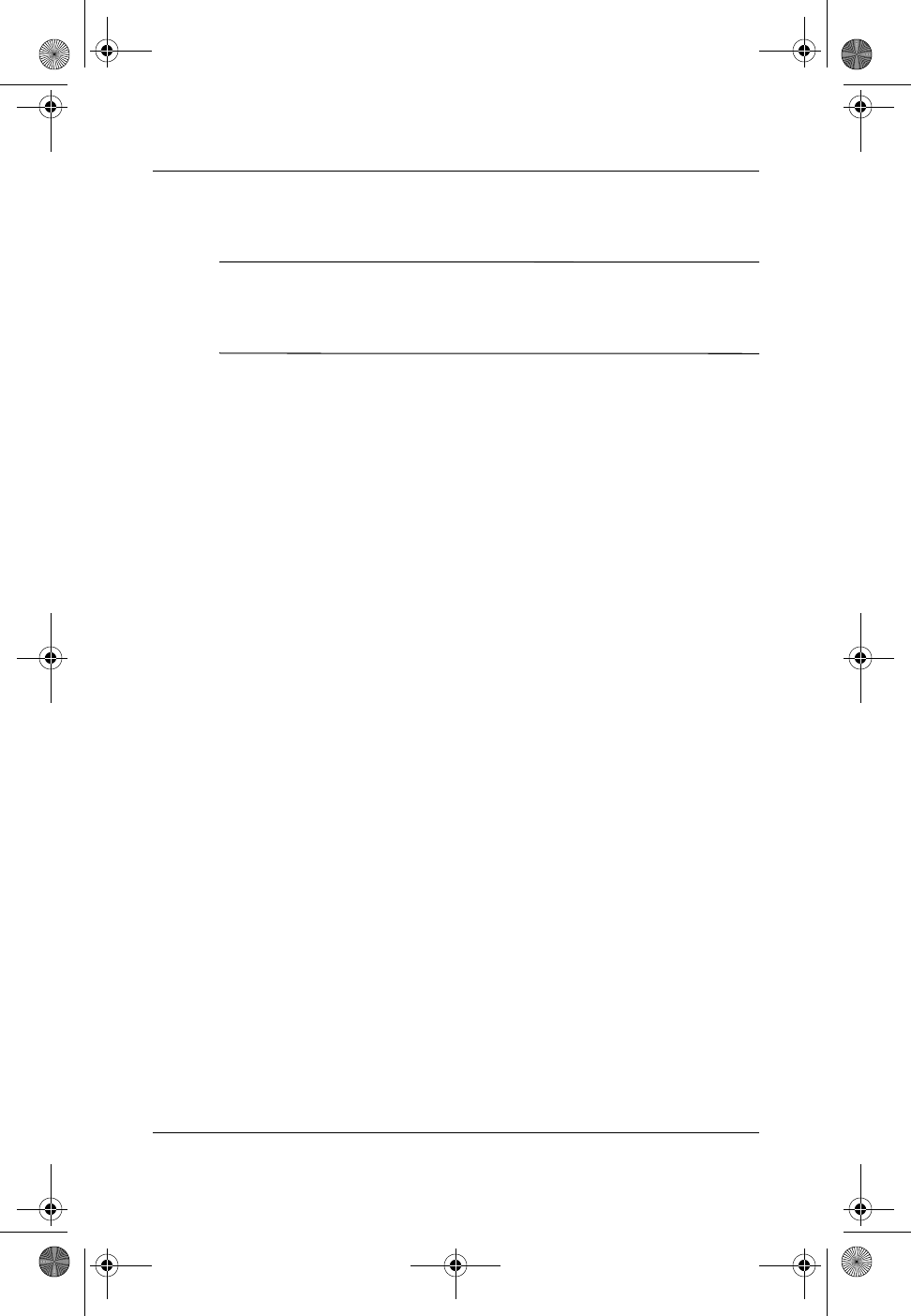
Battery Packs and Power Management
Startup Guide 3–3
To Recharge the Battery Pack
ÄCAUTION: The AC adapter is normally warm when plugged into an
AC outlet. The notebook is normally warm while recharging. Do not
recharge the notebook in a briefcase or other confined space, or the
battery pack could overheat.
»Plug the AC adapter into the notebook.
Charging can take several hours. If you continue working while
the battery pack charges, the charging time may increase.
The operating time for a fully charged battery pack depends
on the notebook model, power management settings, and level
of use.
To Get the Most from Your Battery Packs
Follow these suggestions to make your battery power last as long
as possible:
■Plug in the AC adapter, especially when using a CD-ROM
or DVD-ROM drive, or any external connections such as a
PC Card or a modem.
■Set the display brightness to the lowest comfortable level
(Fn+F1).
■Put the notebook in Standby when you will not be using it for
a short while.
■Put the notebook in Hibernation whenever you want to save
your current session but will not be using the notebook for
a day or more.
■Set the automatic timeout settings to emphasize saving
power. If your notebook has a multispeed processor, use the
lower speed on battery power (the default settings conserve
battery power).
HP_SU_370699-001.book Page 3 Thursday, May 13, 2004 4:39 PM
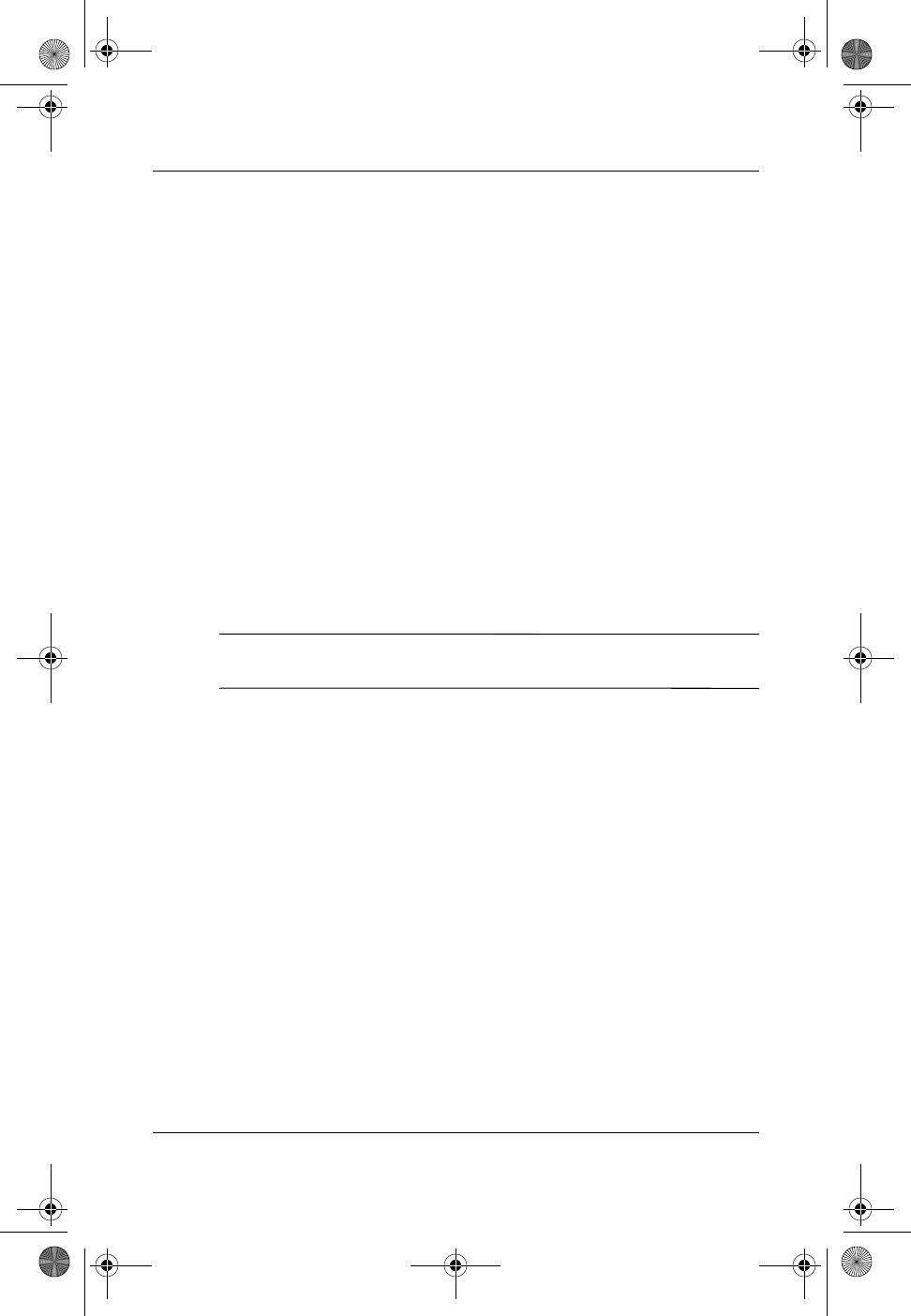
3–4 Startup Guide
Battery Packs and Power Management
■If your notebook has a wireless on-off button, turn off
the wireless function when you are not using it. Press the
wireless on-off button to turn off the light.
■If you have a PC Card, such as a network card, remove it
when you are not using it. Some PC Cards use significant
power even while they are inactive.
■If you work with an application that uses the serial port or a
PC Card, exit the application when you finish using it.
In addition, follow these suggestions to extend the life of your
battery packs:
■Do not leave battery packs unused for long periods. If you
have more than one, rotate them.
■Unplug the AC adapter when the notebook is not in use.
■If the notebook will be unused and unplugged for more than
2 weeks, remove and store the battery pack.
ÄCAUTION: To prevent damage to the battery pack, do not expose it to
high temperatures for extended periods of time.
■High temperatures accelerate the self-discharge rate of a
stored battery pack. To prolong the charge of a stored battery
pack, place it in a cool, dry location.
■To maintain the accuracy of battery charge displays, calibrate
a battery pack that has been stored for one month or more
before using it.
■Avoid using or charging battery packs at high temperatures.
HP_SU_370699-001.book Page 4 Thursday, May 13, 2004 4:39 PM
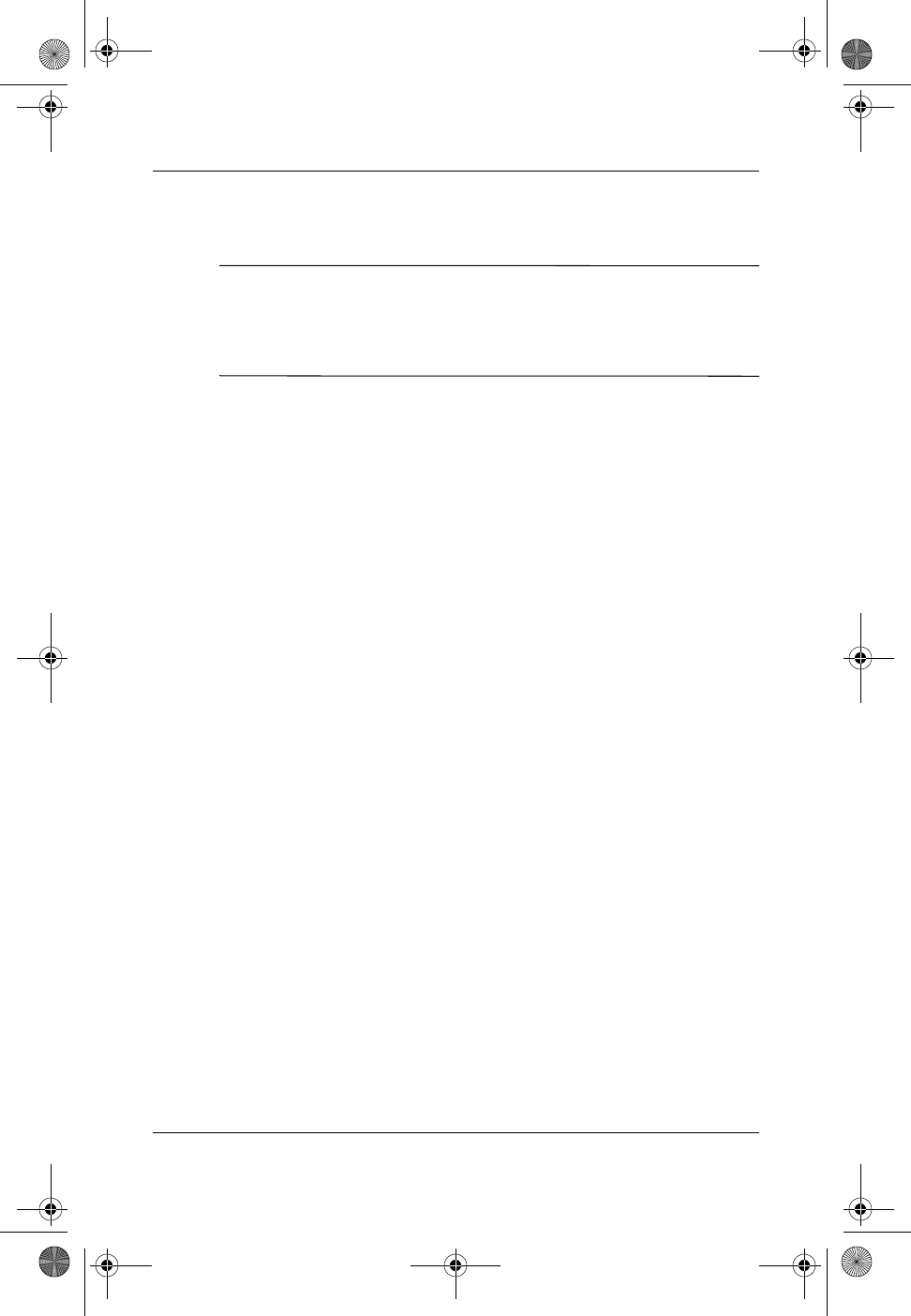
Battery Packs and Power Management
Startup Guide 3–5
Disposing of a Used Battery Pack
ÅWARNING: There is a risk of fire and chemical burn if a battery pack
is handled improperly. Do not disassemble, crush, or puncture a battery
pack or short the contacts on a battery pack. Do not expose a battery
pack to temperatures higher than 60°C (140°F) or dispose of a battery
pack in water or fire.
When a battery pack has reached the end of its useful life, do not
dispose of it in general household waste.
■In Europe, dispose of or recycle battery packs by using the
public collection system or by returning them to HP, your
service partner, or their agents.
■In other regions, refer to the Worldwide Telephone Numbers
booklet, included with the notebook, to contact HP and
request information about battery pack disposal.
For more information about battery pack precautions and disposal
and the complete text of governmental agency notices, refer to the
Regulatory and Safety Notices guide on the Documentation CD.
HP_SU_370699-001.book Page 5 Thursday, May 13, 2004 4:39 PM
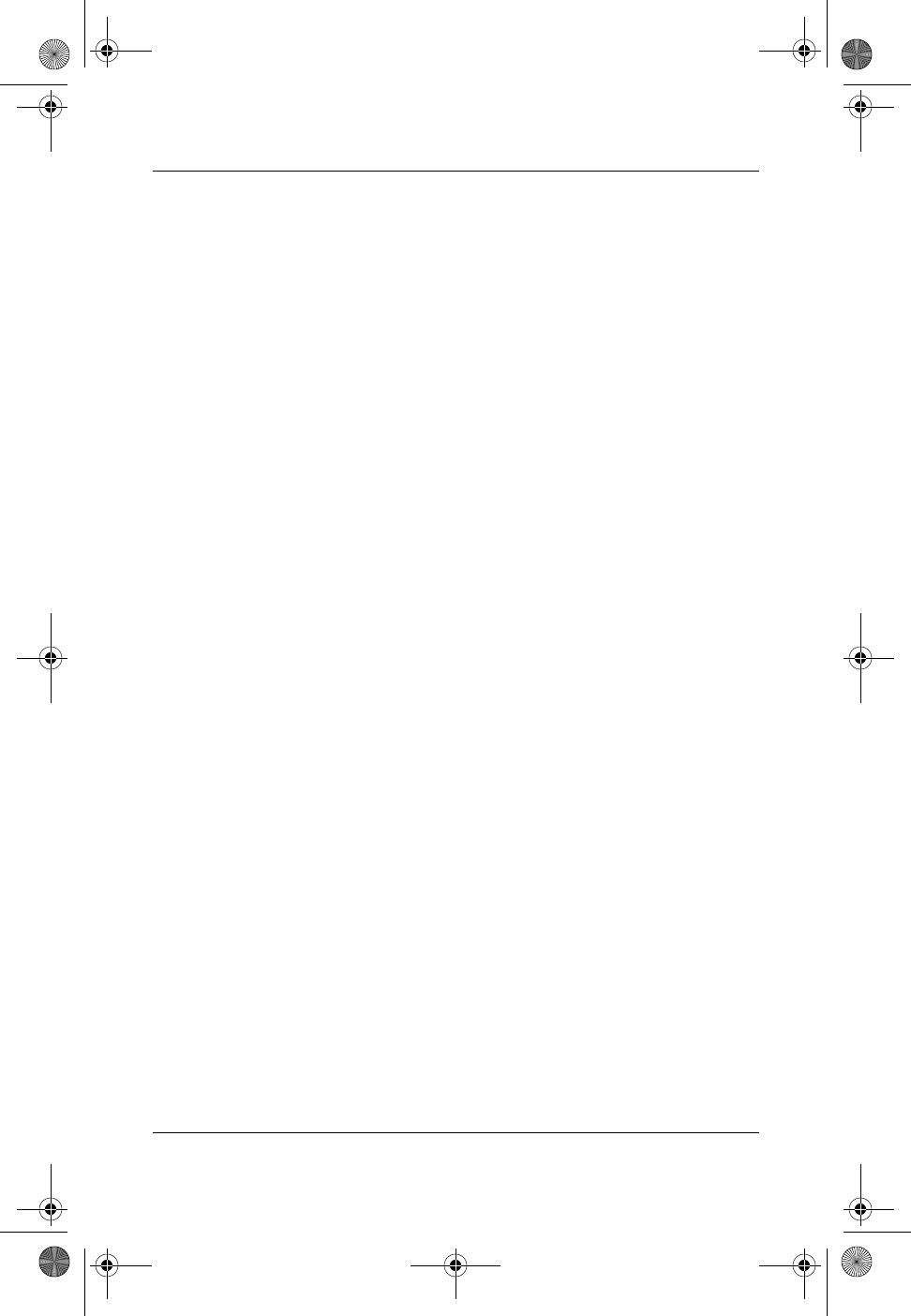
3–6 Startup Guide
Battery Packs and Power Management
HP_SU_370699-001.book Page 6 Thursday, May 13, 2004 4:39 PM
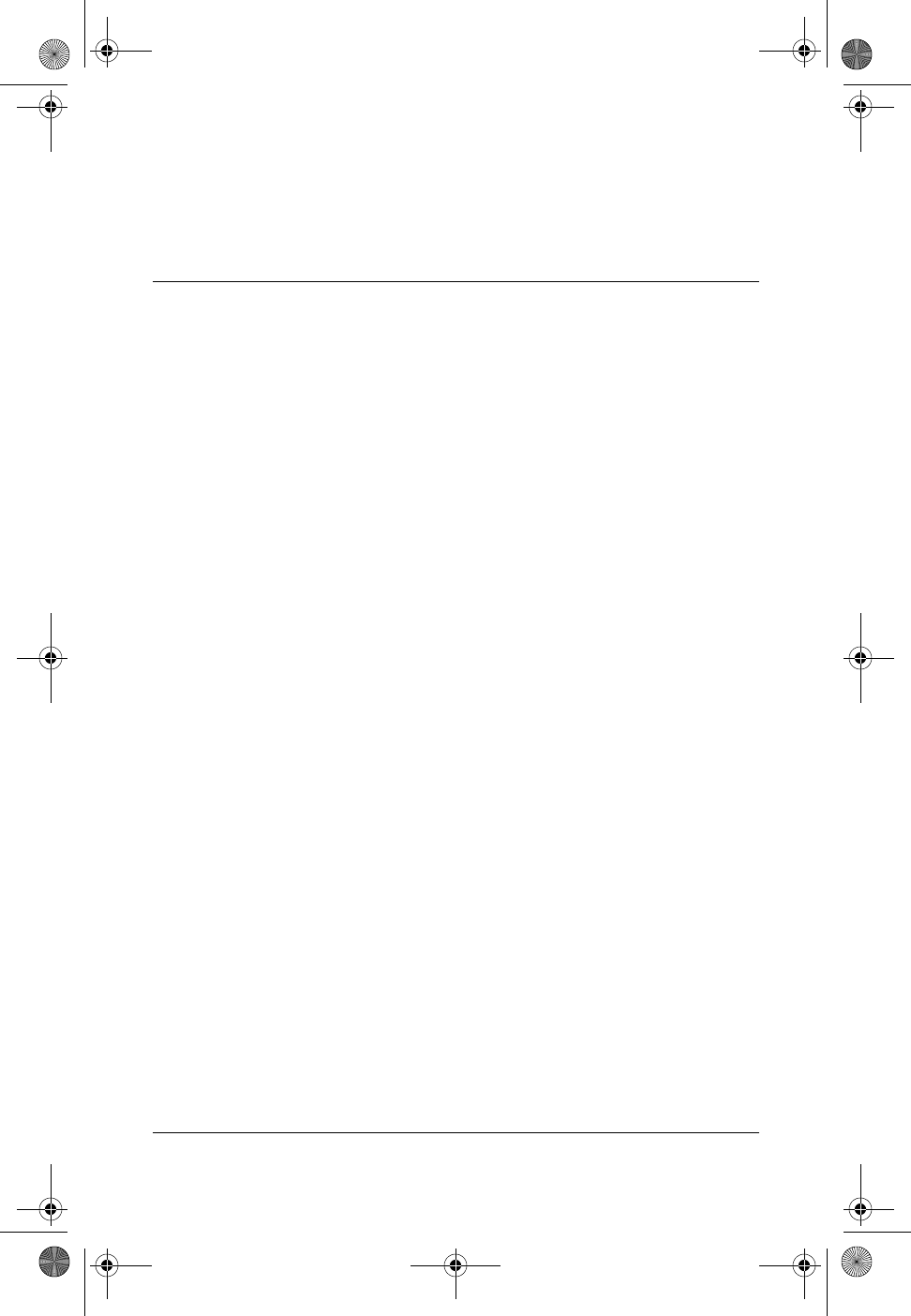
Startup Guide 4–1
4
Troubleshooting
Troubleshooting Your Notebook
This chapter contains solutions to many types of problems you
might have with your notebook. Try the solutions one at a time, in
the order in which they are presented.
Here are some other sources of information for troubleshooting:
■For a more complete list of troubleshooting suggestions, see
the “Troubleshooting” chapter in the Reference Guide on the
Documentation CD included with your notebook.
■Use the Windows troubleshooters. Select Start > Help and
Support.
■Select the question mark One-Touch key located at the top of
the keyboard.
■See the Microsoft Windows manual shipped with the
notebook.
■Refer to the Worldwide Telephone Numbers booklet to
contact a Customer Care Center for help and support.
HP_SU_370699-001.book Page 1 Thursday, May 13, 2004 4:39 PM
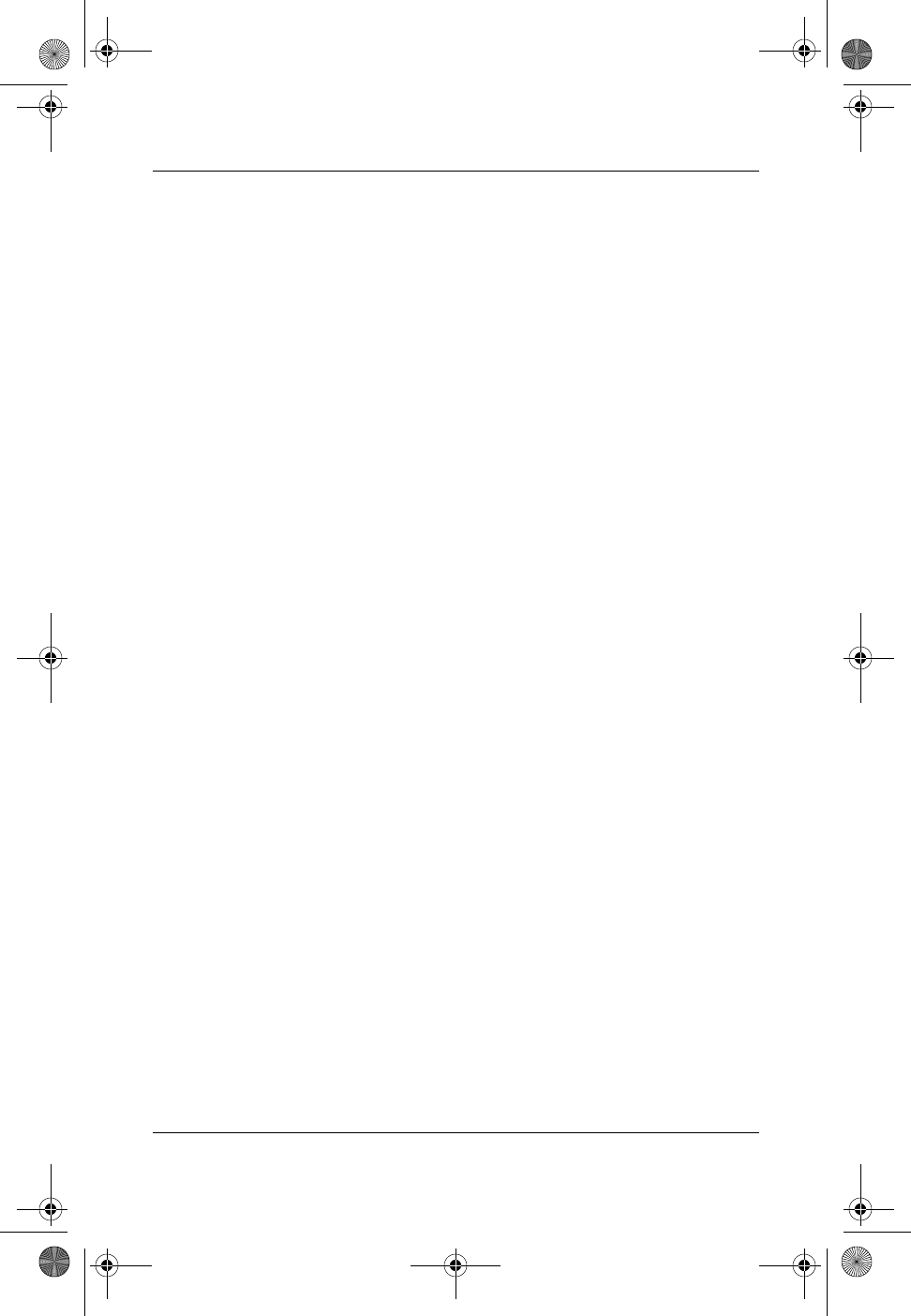
4–2 Startup Guide
Troubleshooting
Display Problems
If the Notebook Is On, But the Screen Is Blank
■Move the mouse or tap the TouchPad. This will wake the
display if it is in Display-off mode.
■If the notebook is cold, allow it to warm up.
If the Screen Is Difficult to Read
■Try setting the display resolution to its default setting of
1024 × 768 or higher, depending on your model. Select
Start > Control Panel > Appearance and Themes > Display.
■Try adjusting the size of the desktop icons and labels.
If an External Display Does Not Work
■Check the connections.
■The external monitor may not be detected. In the BIOS Setup
utility, try setting Video Display Device to Both in the System
Devices menu.
■If you are using a TV connected to the optional S-Video port,
you must activate the TV.
HP_SU_370699-001.book Page 2 Thursday, May 13, 2004 4:39 PM
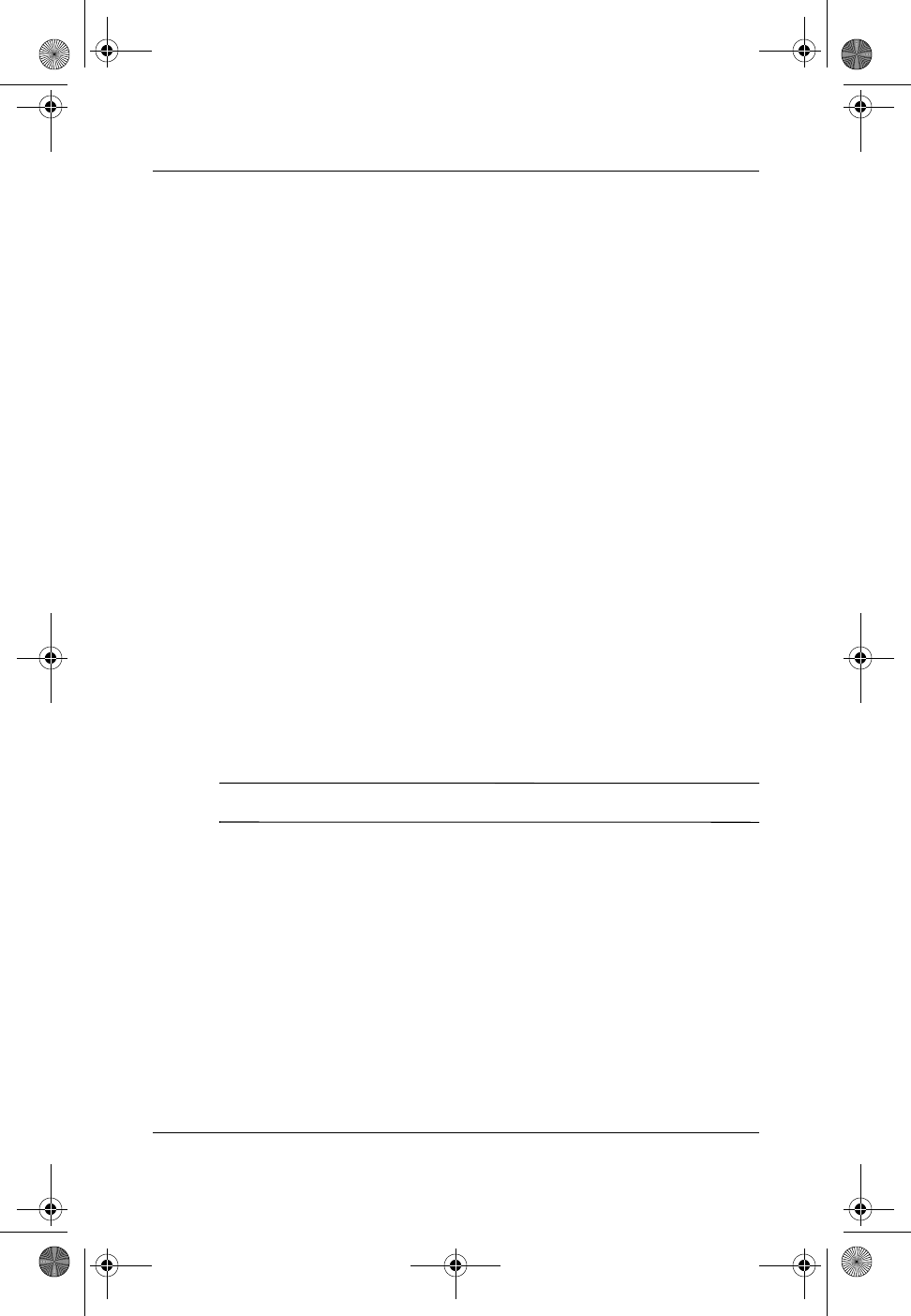
Troubleshooting
Startup Guide 4–3
Hard Drive Problems
If the Notebook Hard Drive Does Not Spin
■Make sure the notebook has power. If necessary, connect the
AC adapter, and make sure it is fully plugged into a power
source and into the back of the notebook.
■Remove and reinsert the hard drive.
If Files Are Corrupted
■Open My Computer, and the disk you want to scan. Select
File > Properties. Select the Check Now box under the
Error-checking section of the Tools tab.
■Run the virus-scanning program.
■If necessary, you can format the hard disk and reinstall the
original factory software using the system recovery features
described in the “Troubleshooting” chapter of the Reference
Guide.
Keyboard and Pointing Device Problems
✎Use these suggestions for built-in or external devices.
If the Pointer Is Difficult to Control
Adjust the pointer controls. Select Start > Control Panel >
Printers and Other Hardware > Mouse.
HP_SU_370699-001.book Page 3 Thursday, May 13, 2004 4:39 PM
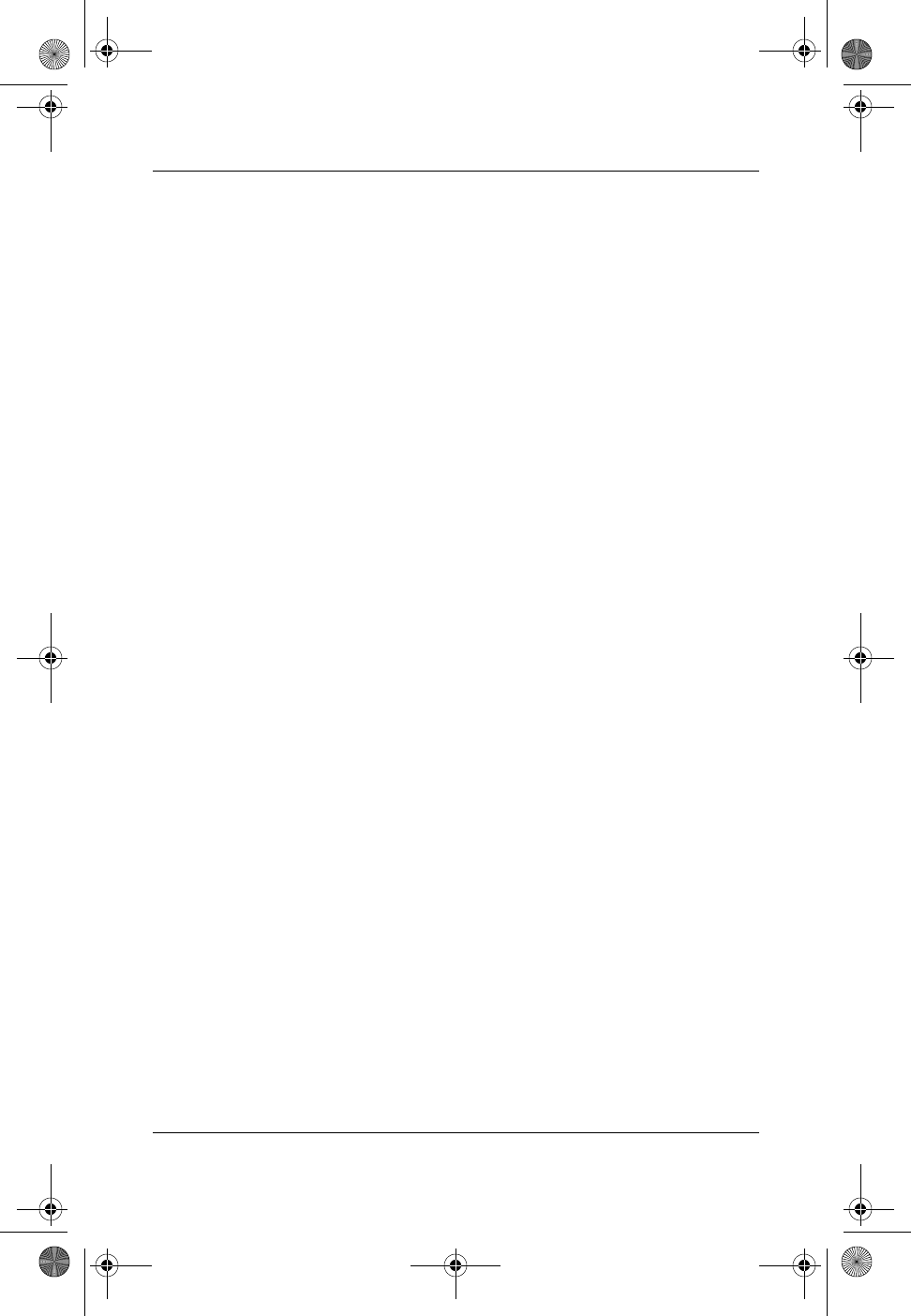
4–4 Startup Guide
Troubleshooting
If the TouchPad Does Not Work
■Press the TouchPad on-off button to turn on the light.
■Do not touch the TouchPad while the notebook is rebooting
or resuming from Standby mode. If this happens, try the
following: press a key on the keyboard to restore normal
operation.
■If an external mouse is connected, the built-in pointing
devices are normally disabled. You can change this setting
with the BIOS Setup utility. See “Configuring Your
Notebook” in this chapter.
■Restart the notebook. Select Start > Turn Off Computer >
Restart.
If the Notebook Stops Responding
■Press ctrl+alt+del and use Task Manager to end the application
that is not responding.
■Press the power button for at least 4 seconds to turn off and
reset the notebook. Unsaved data will be lost. Then press the
power button again to turn the notebook back on.
■If nothing happens, insert the tip of a paper clip into the
reset button on the bottom of the notebook. Then press
the power button to turn the notebook back on.
■To avoid lockup problems, avoid pressing the TV Now!
One-Touch button to switch display devices while
graphic-intensive applications are running. Also avoid
turning the notebook off or putting it into Standby while such
applications are running.
HP_SU_370699-001.book Page 4 Thursday, May 13, 2004 4:39 PM
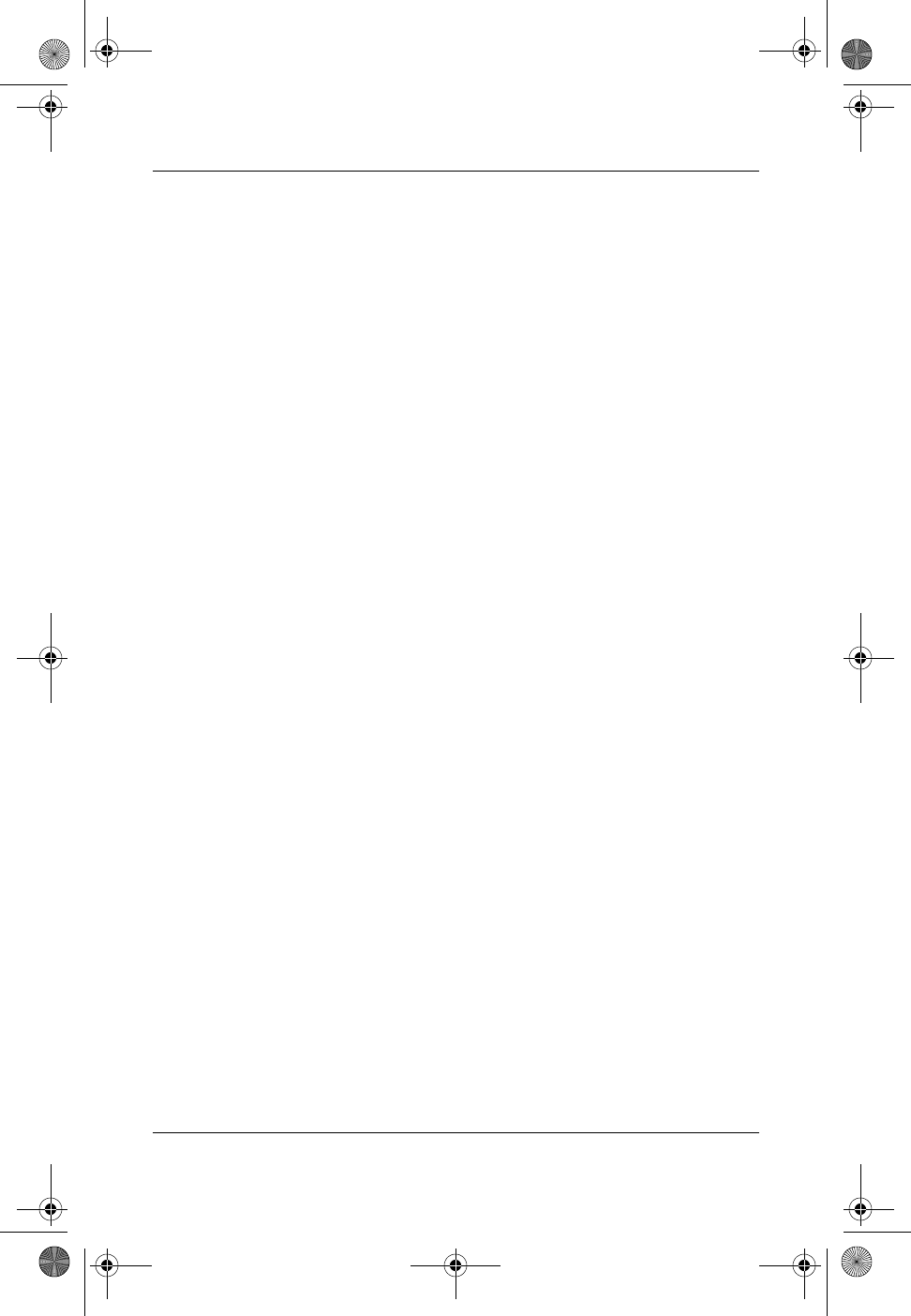
Troubleshooting
Startup Guide 4–5
Power and Battery Pack Problems
If the Notebook Turns Off Immediately After It
Turns On
Battery power is probably extremely low. Plug in the AC adapter
or insert a charged battery pack.
If the Notebook Keeps Beeping
The notebook beeps repeatedly or displays a warning when
battery power is low. Save your work, shut down Windows
immediately, and insert a charged battery pack or plug in the
AC adapter.
If the Battery Pack Does Not Charge
■Make sure the AC adapter is fully plugged into the
power source and the notebook, and that the battery charging
light on the notebook is on.
■If you are using a power strip, remove the AC adapter from
the power strip and plug it directly into a wall outlet.
■Make sure the battery pack is fully installed and locked in
place.
■Make sure you are using only the AC adapter included with
your notebook (or other approved adapter that meets the
power requirements of the notebook). Do not use a 60-watt,
3.16-amp adapter.
■Move the notebook away from any nearby heat source.
Unplug the AC adapter and allow the battery pack to cool
down. If the battery pack gets too hot, it will not charge
properly.
■If available, try another battery pack and AC adapter.
HP_SU_370699-001.book Page 5 Thursday, May 13, 2004 4:39 PM
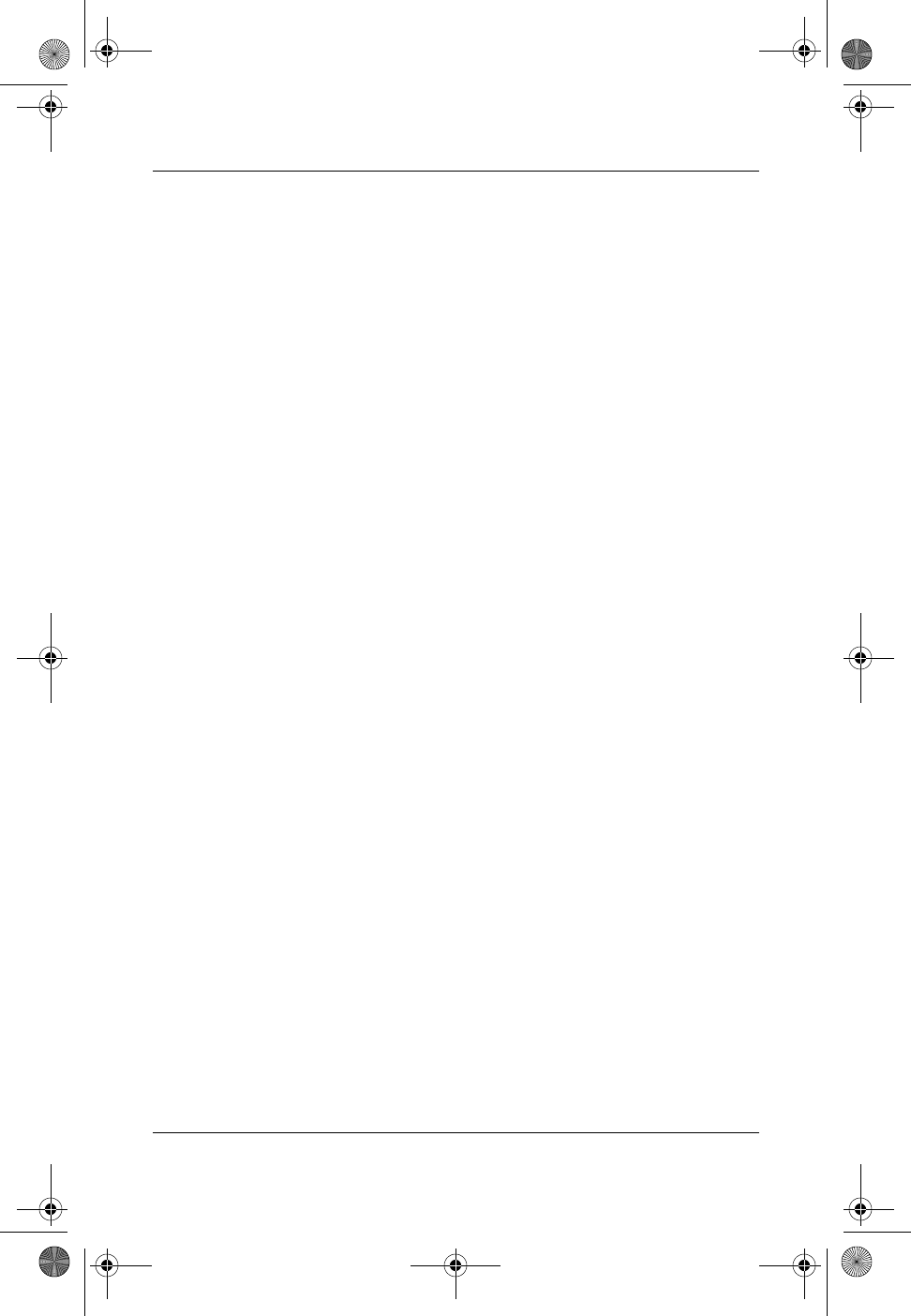
4–6 Startup Guide
Troubleshooting
Startup Problems
If the Notebook Does Not Respond When You
Turn It On
■Connect the AC adapter.
■Reset the notebook by inserting the tip of a paper clip into
the reset button on the bottom of the notebook. Then press the
power button to turn it on.
■If the notebook still does not respond, remove the battery
pack and AC adapter, remove any PC Cards, and undock the
notebook if docked. Then plug in the AC adapter again, and
reset the notebook using the reset button.
If the Notebook Will Not Boot from Battery Power
■Make sure the battery pack is properly inserted and fully
charged. Check the battery charge by removing it and
pressing the pad on the side of the battery pack. The lights
show the charge level.
■If available, try another battery pack.
HP_SU_370699-001.book Page 6 Thursday, May 13, 2004 4:39 PM
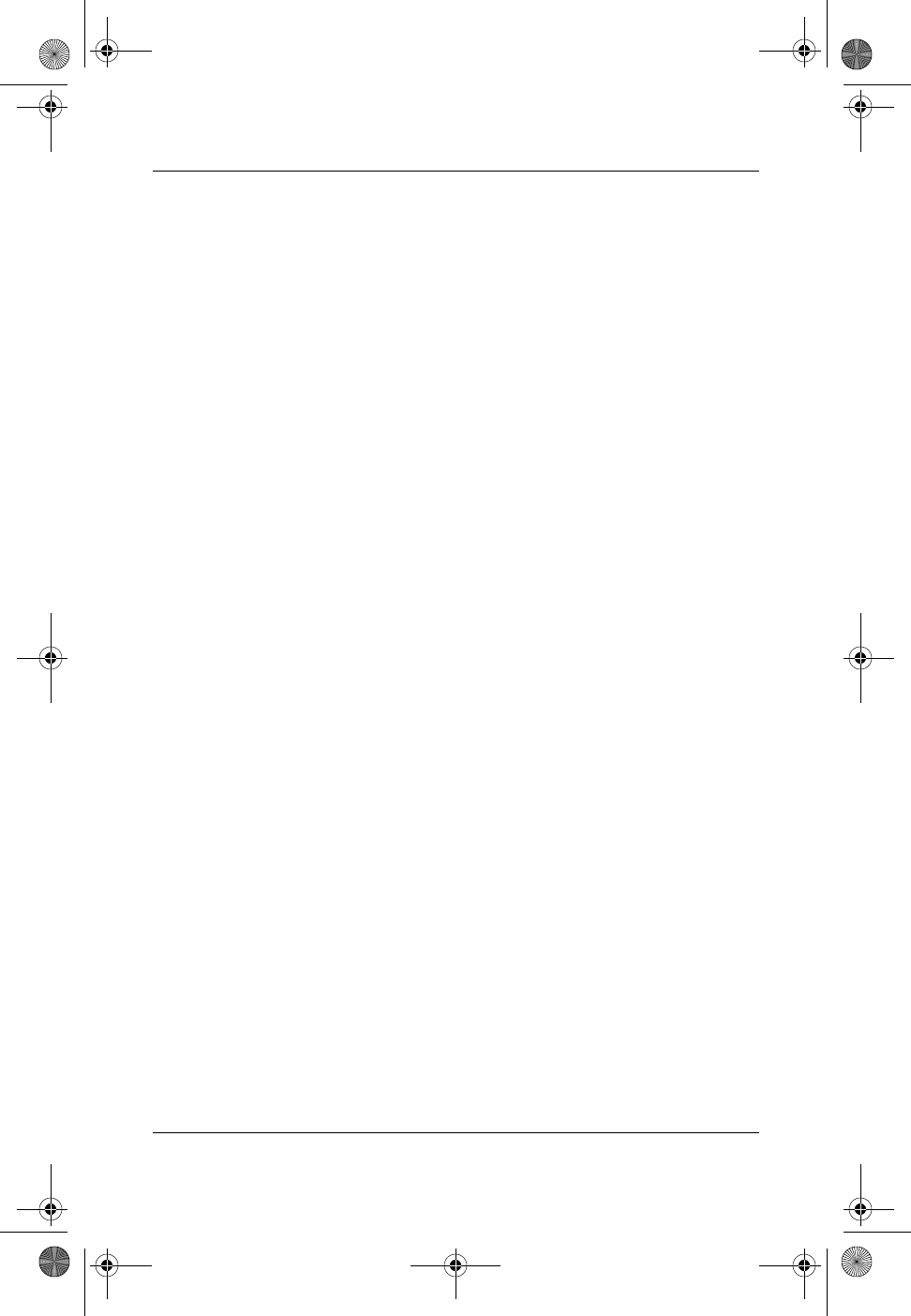
Troubleshooting
Startup Guide 4–7
Configuring Your Notebook
The BIOS Setup utility helps you configure your notebook
operation.
To Run the BIOS Setup Utility
The BIOS (basic input and output system) Setup utility enables
you to make changes to the notebook system configuration, and
to tailor the operation of your notebook to your individual work
needs.
The settings made in BIOS Setup generally control the notebook
hardware, and so greatly affect how the notebook operates.
1. Select Start > Turn Off Computer > Restart.
2. When the logo screen appears, press F2 to enter BIOS Setup.
3. The pointing devices are not active in BIOS Setup, so you
will need to use the keyboard to navigate:
❏Press the left and right arrow keys to move among menus.
❏Press the up and down arrow keys to move among
parameters in a menu.
❏Press + or - to move through values for the current
parameter, or press enter to change a setting.
4. After you select the options you want, press F10 or use the
Exit menu to exit BIOS Setup.
5. If the settings cause a conflict between devices during reboot,
the system prompts you to run BIOS Setup, and marks the
conflicting settings.
HP_SU_370699-001.book Page 7 Thursday, May 13, 2004 4:39 PM
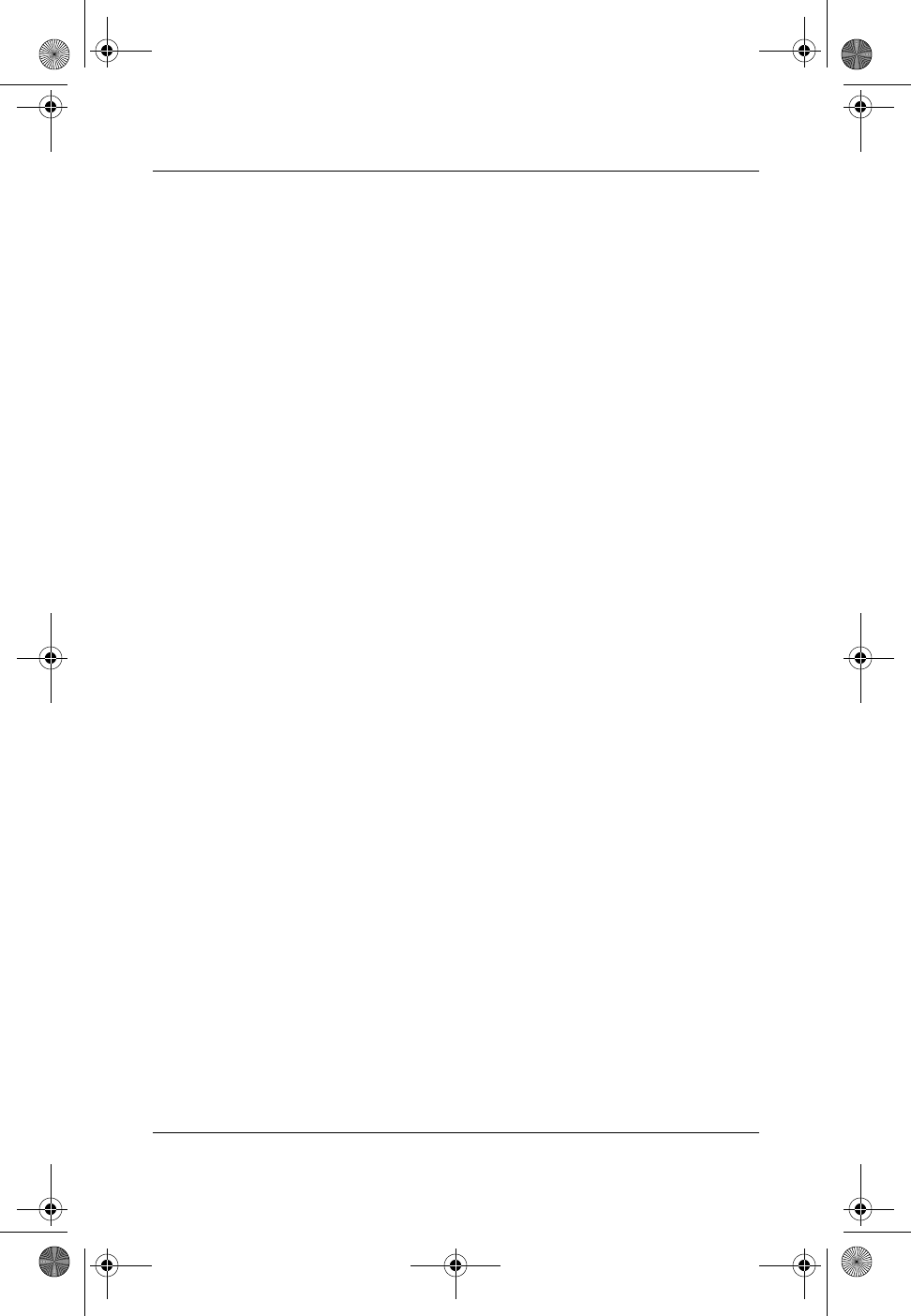
4–8 Startup Guide
Troubleshooting
Updating Software and Drivers from
the Web
Software and driver updates for your notebook are available
for download. For more information, visit the Web site at
http://www.hp.com/support.
Using System Recovery Features
The notebook system recovery process provides several options
for recovering optimal system functionality. System Restore and
OS CDs (operating system CDs) enable you to recover or repair
your notebook without losing personal data. The OS CD also
enables reinstallation of the operating system software provided
with the notebook.
For detailed information, see the “Troubleshooting” chapter in
the Reference Guide.
HP_SU_370699-001.book Page 8 Thursday, May 13, 2004 4:39 PM
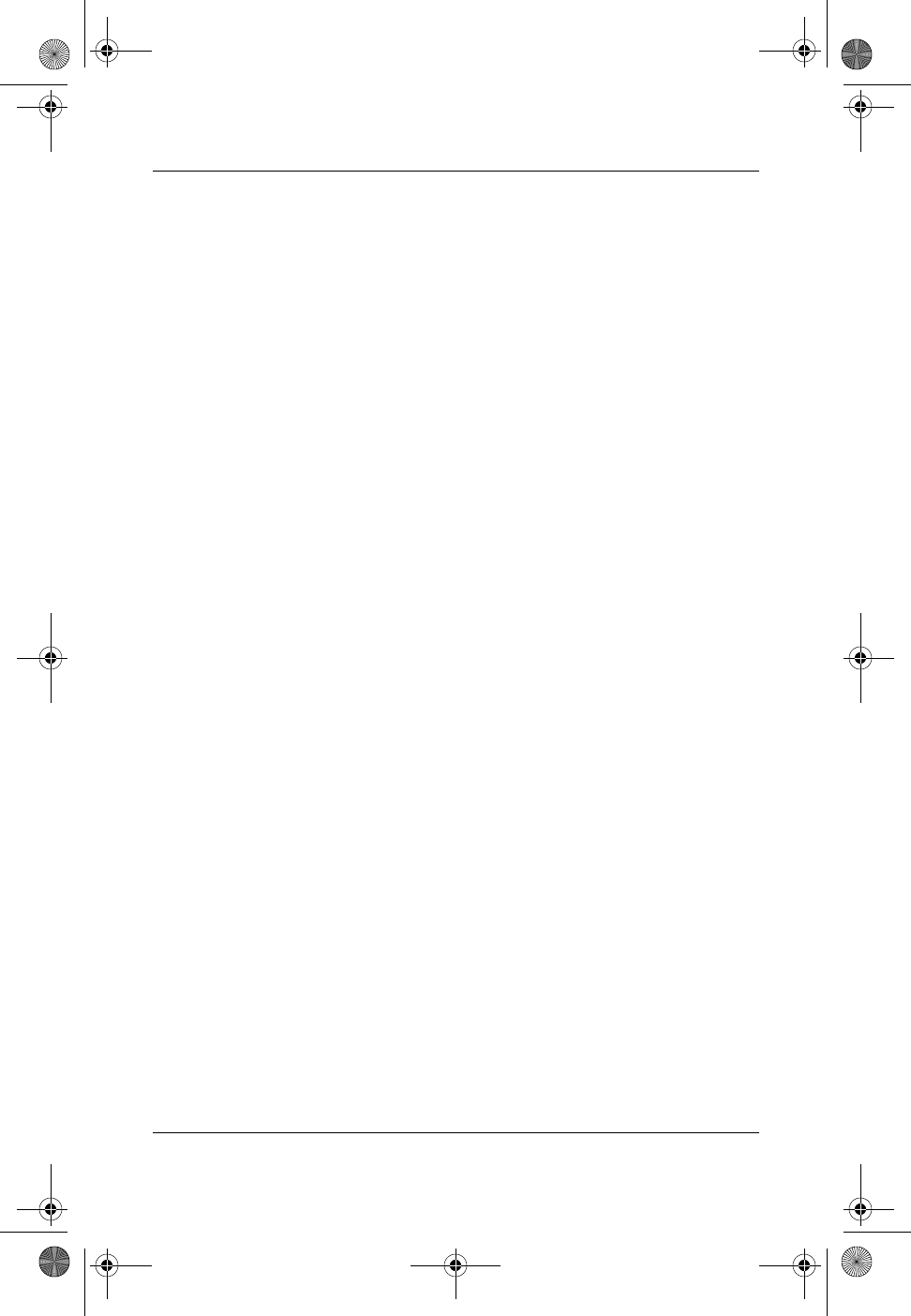
Troubleshooting
Startup Guide 4–9
Safeguarding Your Data
Software or devices added to the notebook can cause your system
to become unstable. To safeguard your documents, store personal
files in the My Documents folder and periodically create a
backup copy of My Documents. Setting System Restore points is
also recommended.
Your notebook sets System Restore points (benchmarks) daily as
you change your personal settings. The notebook may also set
restore points when you add new software or devices. You should
periodically set personal restore points when the notebook is
functioning at optimal performance and before installing new
software or devices. This enables you to return to a previous
configuration restore point if you encounter problems.
To set a system restore point:
1. Select Start > Help & Support. Select the task Use Tools to
view your computer information and diagnose problems.
Select System Restore. A System Restore window opens.
2. Follow the on-screen directions for setting a restore point.
To restore the notebook to a previous date and time when it was
functioning optimally:
1. Select Start > Help & Support > Tools > System Restore.
2. Follow the on-screen directions for restoring the notebook.
HP_SU_370699-001.book Page 9 Thursday, May 13, 2004 4:39 PM
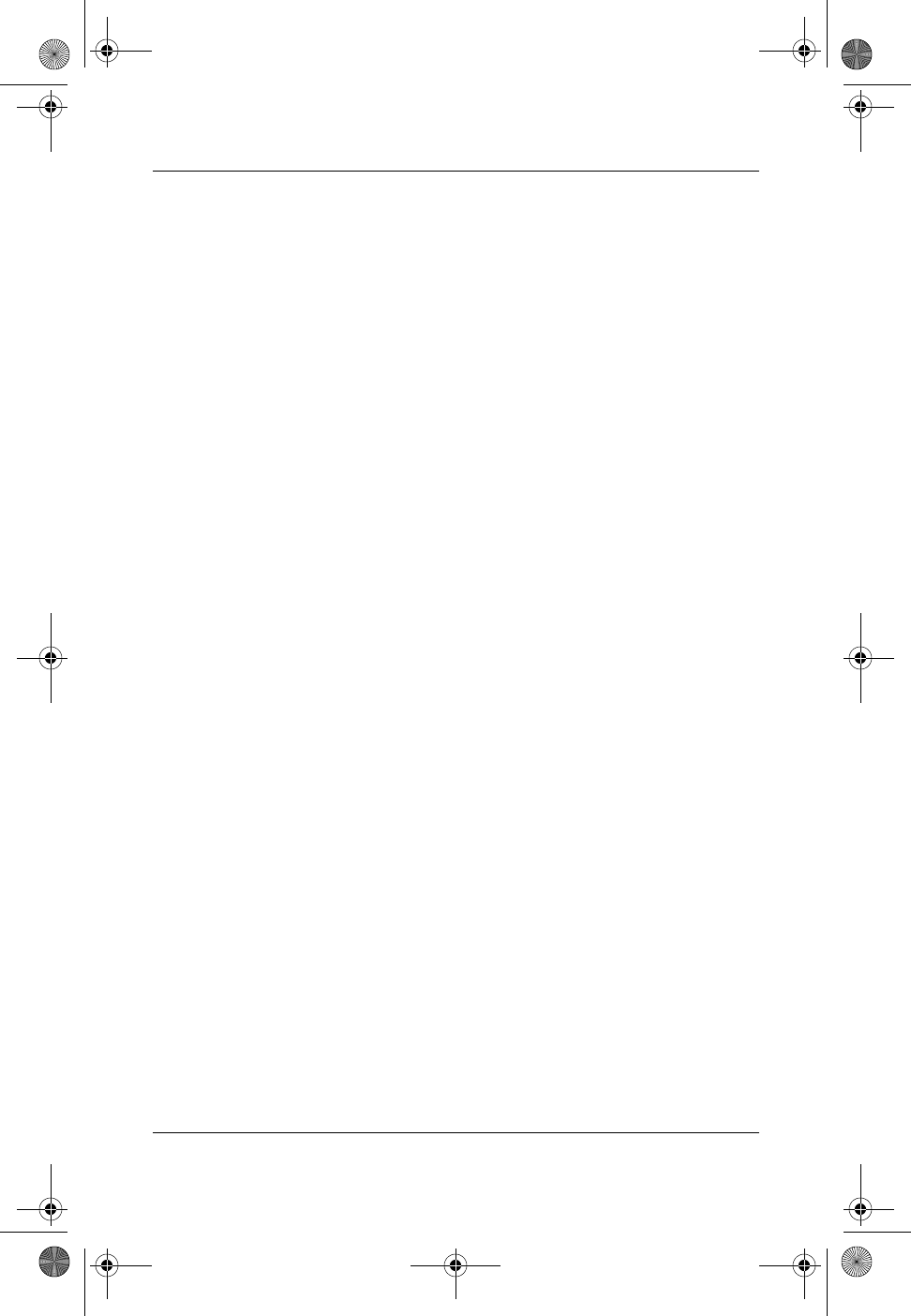
4–10 Startup Guide
Troubleshooting
Operating System (OS) CD Repair
To repair the operating system without deleting your personal
data, use the standard Microsoft OS CD that was shipped with the
notebook. This CD contains the following preinstalled operating
systems:
■Microsoft Windows XP Home or Pro (depending on
configuration)
■Appropriate service pack
To repair the operating system:
1. Connect the notebook to external power and turn on the
notebook.
2. Immediately insert the OS CD into the notebook.
3. Press and hold the power button for 5 seconds to turn off the
notebook.
4. Press the power button again to start the notebook.
5. When prompted, press any key to boot from CD. After a few
minutes, the Welcome to Setup screen is displayed.
6. Press enter to continue. A Licensing Agreement screen is
displayed.
7. Press F8 to accept the agreement and continue. The Setup
window opens.
8. Press R to repair the selected Windows installation. The repair
process begins. This process takes 1 to 2 hours to complete.
The notebook restarts in Windows after the process is
complete.
HP_SU_370699-001.book Page 10 Thursday, May 13, 2004 4:39 PM
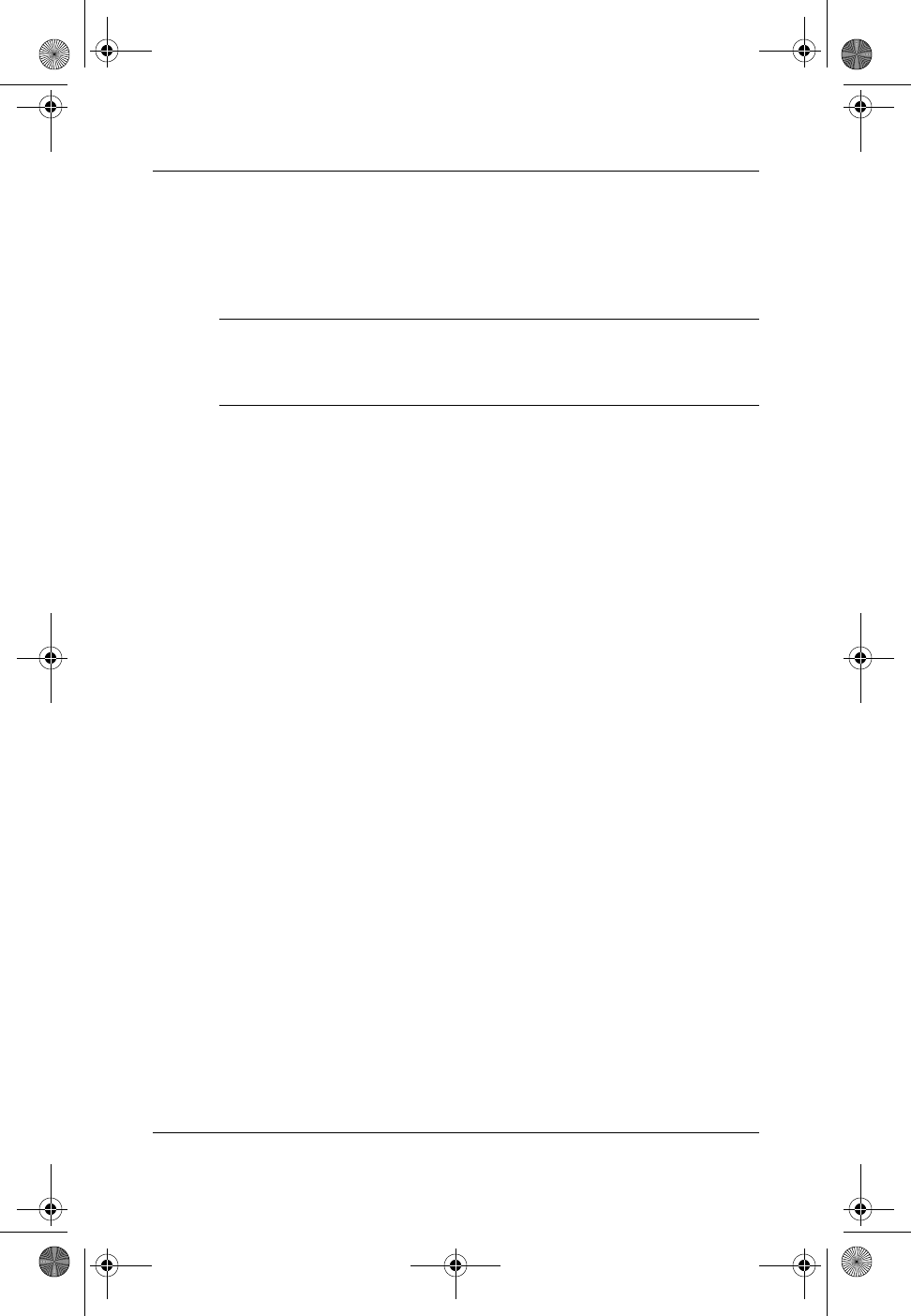
Troubleshooting
Startup Guide 4–11
OS CD Reinstall
If other recovery efforts do not successfully repair the notebook,
you can reinstall the operating system.
ÅWARNING: Personal data and software you have installed on the
notebook will be lost during the OS CD reinstall. To protect your data,
make a backup copy of My Documents before reinstalling your operating
system. Visit Help and Support to learn more about backing up your files.
To reinstall the operating system:
1. Connect the notebook to external power and turn on the
notebook.
2. Immediately insert the OS CD into the notebook.
3. Press and hold the power button for 5 seconds to turn off the
notebook.
4. Press the power button again to start the notebook.
5. When prompted, press any key to boot from the CD. After a
few minutes, the Welcome to Setup screen opens.
6. Press enter to continue. A Licensing Agreement screen is
displayed.
7. Press F8 to accept the agreement and continue. The Setup
window is displayed.
8. Press esc to continue installing a fresh copy of the operating
system without repairing.
9. Press enter to set up the operating system.
10. Press C to continue setup using this partition.
HP_SU_370699-001.book Page 11 Thursday, May 13, 2004 4:39 PM

4–12 Startup Guide
Troubleshooting
11. Select Format the partition using the NTFS file system
(Quick) and press enter. A caution is displayed that formatting
this drive will delete all current files.
12. Press F to format the drive. The reinstallation process begins.
This process takes 1 to 2 hours to complete. The notebook
restarts in Windows after the process is complete.
✎When prompted for the product key, refer to the Microsoft
Certificate of Authenticity located on the bottom of the notebook.
Reinstalling Drivers
After the OS installation process is complete, you must reinstall
drivers. Use the Driver Recovery CD with the OS CD for
hardware driver and system utility refresh and for full system
software restoration.
To reinstall drivers:
1. While running Windows, insert the Driver Recovery CD into
the optical drive.
2. If you do not have Autorun enabled, select Start > Run. Then
type D:\SWSETUP\APPINSTL\SETUP.EXE (where D indicates the
optical drive).
3. Select the desired driver(s) or system utility from the Driver
Recovery CD menu.
4. Select Next to complete the installation.
Restoring Software Applications
After the drivers are reinstalled, you must reinstall any software
you added to the notebook. Use the Application Recovery and
third-party CDs to reinstall or continue restoring software
applications. Follow the installation instructions provided with
the software CDs included with the notebook.
HP_SU_370699-001.book Page 12 Thursday, May 13, 2004 4:39 PM
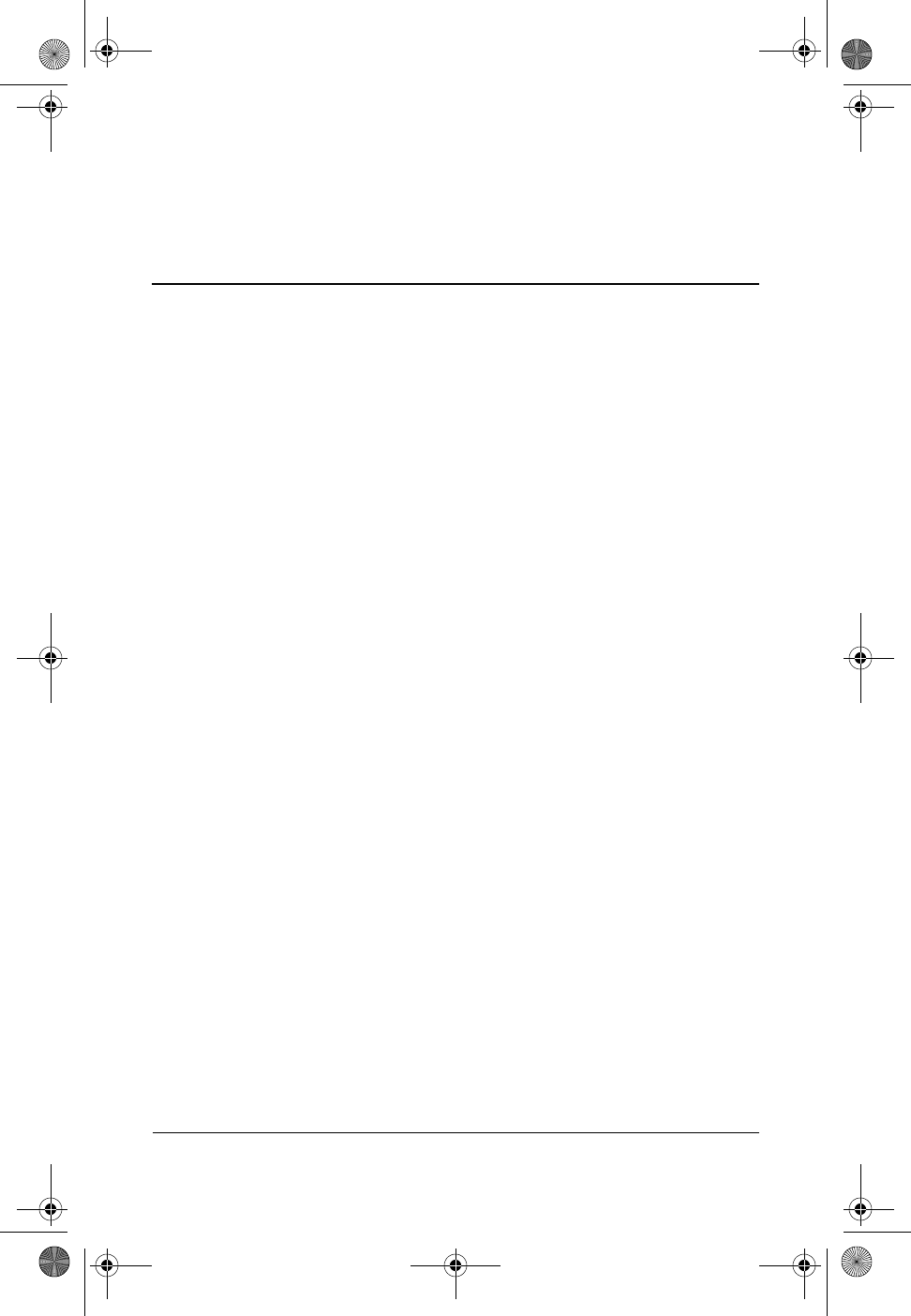
Startup Guide Index–1
Index
1394 port location 1–4
A
AC adapter
connecting 1–9
jack location 1–4
Acrobat Reader 1–12
adjusting
brightness 2–6
volume 2–6
audio
adjusting volume 2–6
jack location 1–4
mute button 1–4
volume control location 1–4
B
back panel components 1–4
battery packs
checking battery status 1–6,
3–1
disposal and recycling 3–5
disposing of 3–5
extending life of 3–3
installing 1–8
location 1–3
low-battery warning 3–2
recharging 3–3
release latch 1–5
status lights 1–6
troubleshooting 4–5
battery power
check status 3–1
low-battery warning 3–2
battery status lights 3–1
BIOS Setup Utility 4–7
bottom panel components 1–5
brightness, adjusting 2–6
buttons
Click 1–3
One-Touch 1–3
on-off (on TouchPad) 1–3
power 1–3, 1–11
reset 1–5
wireless on-off 1–3
C
cable lock slot 1–4
CD-ROM drive location 1–3
changing the boot device 2–3
Click buttons 1–3
components
back panel 1–4
bottom panel 1–5
front panel 1–3
keyboard status lights 1–3
left panel 1–4
HP_SU_370699-001.book Page 1 Thursday, May 13, 2004 4:39 PM
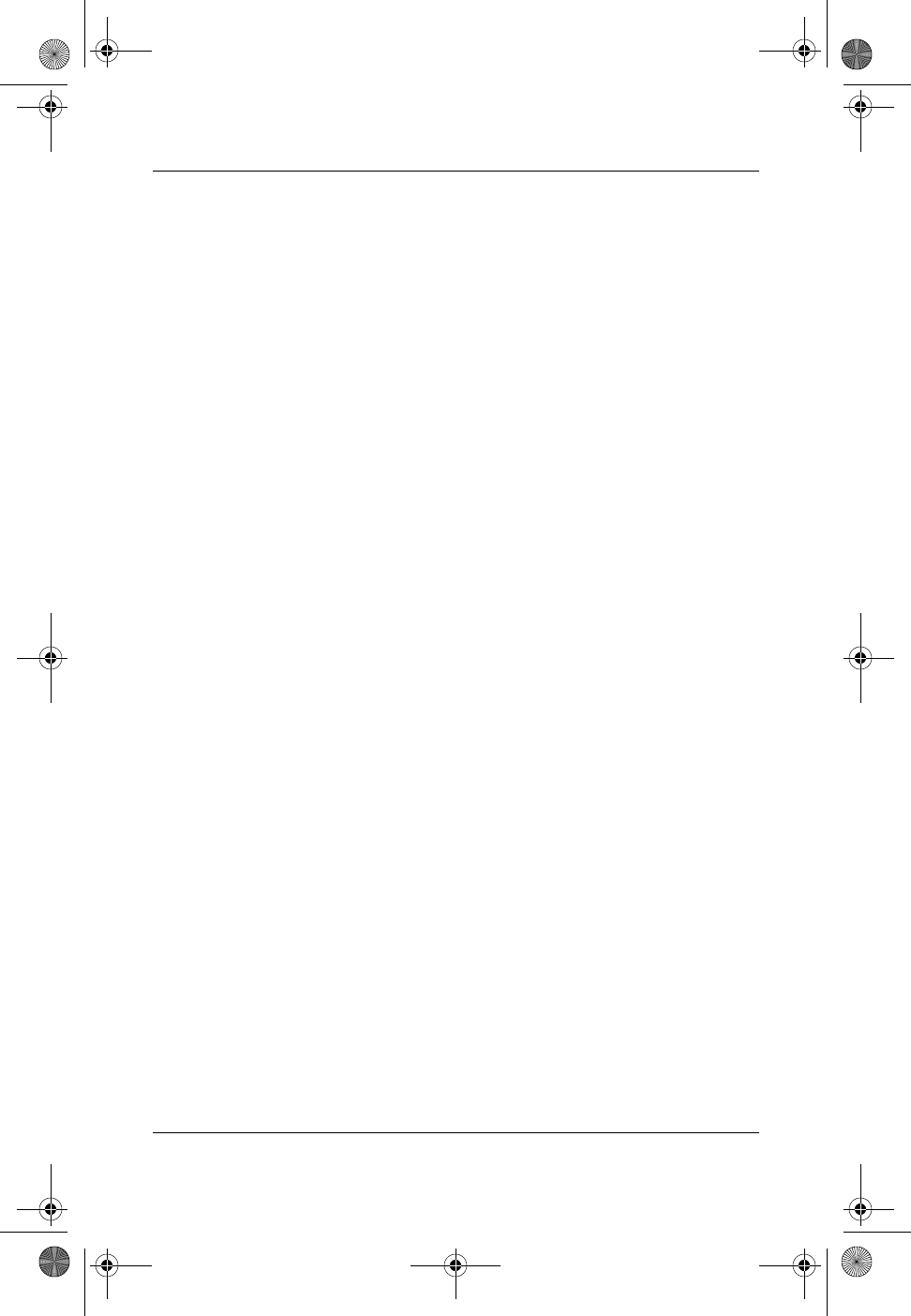
Index–2 Startup Guide
Index
right panel 1–3
status lights 1–2
configuring the notebook 4–7
connecting
AC power 1–9
infrared device 2–8
phone line 1–10
TV (as an external monitor)
2–8
connectors
audio 1–4
RJ-11 (modem) 1–4
RJ-45 (network) 1–4
security 1–4
S-Video out 1–4
D
decreasing display brightness 2–6
diskette drive location 1–4
display
adjusting brightness 2–6
troubleshooting 4–2
Documentation Library CD 1–12
drivers
reinstalling 4–12
DVD drive
creating data disc 2–7
creating movie disc 2–7
location 1–3
playing movies 2–7
setting region code 2–7
E
external monitor
connecting 2–8
port location 1–4
F
front panel components 1–3
function hot keys 2–6
H
hard drive
activity status light 1–6
location 1–3, 1–5
troubleshooting 4–3
Hibernation mode 2–2
hot keys 2–6
I
identifying components 1–2
increasing display brightness 2–6
infrared port
connecting a device 2–8
location 1–3
printing 2–9
transferring files 2–9
using the port 2–9
inserting the battery pack 1–8
K
keyboard
status lights 1–3, 1–7
troubleshooting 4–3
keys 2–6
L
left panel components 1–4
low-battery warning 3–2
M
mini PCI cover 1–5
N
network jack, location 1–4
HP_SU_370699-001.book Page 2 Thursday, May 13, 2004 4:39 PM
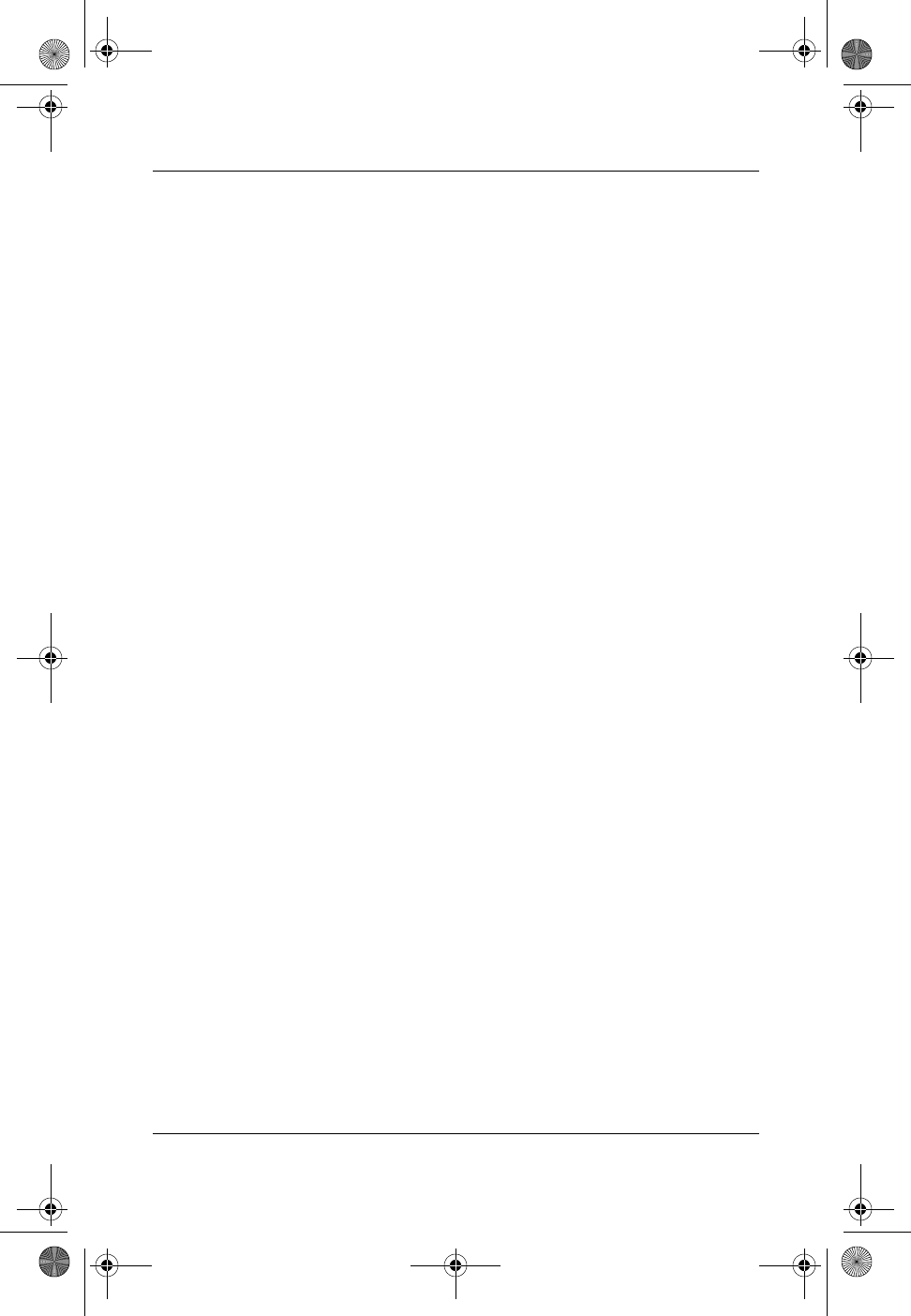
Index
Startup Guide Index–3
O
One-Touch buttons 1–3
on-off button 1–3
open/close latch 1–3
Operating System CD
reinstall 4–11
repair 4–10
P
parallel port (LPT1) 1–4
parts of the notebook
back panel 1–4
bottom panel 1–5
front panel 1–3
left panel 1–4
right panel 1–3
status lights 1–6
PC Card slot location 1–4
ports
1394 1–4
external monitor 1–4
infrared 1–3
LPT1 (parallel) 1–4
serial port (COM1) 1–4
USB 1–4
power
button 1–3, 1–11
mode status light 1–6
settings 2–2
troubleshooting 4–5
R
RAM cover 1–5
recharging the battery pack 3–3
reinstalling
operating system 4–11
software 4–12
reinstalling software 4–8
repairing the operating system
4–10
reset button
location 1–5
using 2–3
restoring software 4–12
right panel components 1–3
RJ-11 (modem) jack
connecting 1–10
location 1–4
RJ-45 (network) jack 1–4
S
safeguarding data 4–9
safety information 1–1
scroll pad, location 1–3
serial port (COM1) 1–4
setting up the notebook
connect phone line 1–10
connect power 1–9
install battery pack 1–8
power on 1–11
set up Windows 1–12
troubleshooting 4–6
setup utility 4–7
slot location
cable lock 1–4
PC Card and CardBus 1–4
software, restoring 4–12
software, updating 4–8
Standby mode 2–2
status lights
battery charge 1–6
hard drive 1–6
keyboard 1–3, 1–7
HP_SU_370699-001.book Page 3 Thursday, May 13, 2004 4:39 PM
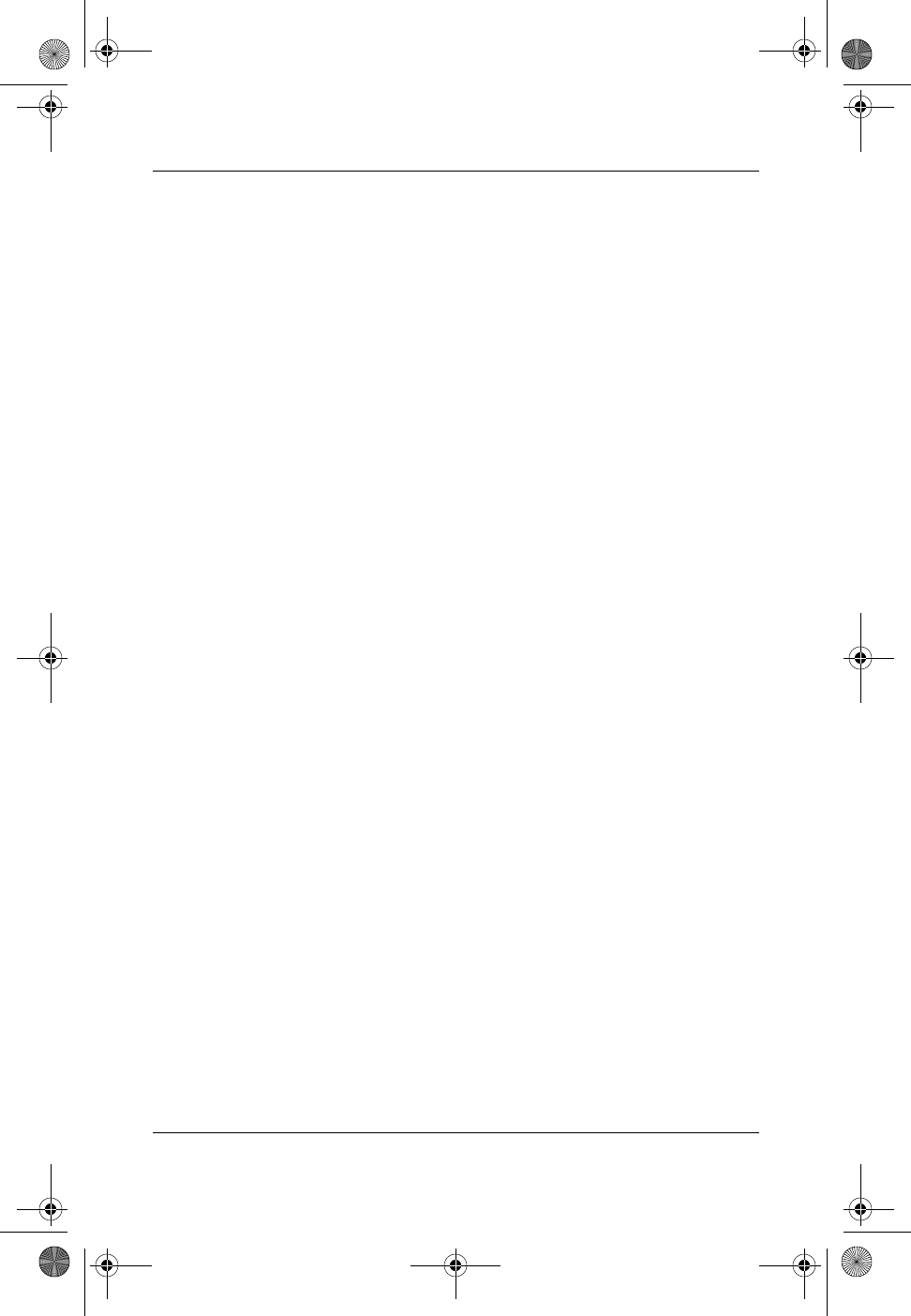
Index–4 Startup Guide
Index
location 1–3
main 1–3, 1–6
meanings 1–6
wireless indicator 1–3
S-Video out jack
location 1–4
using 2–8
system recovery 4–8
T
telephone line connection 1–10
1394 port location 1–4
toggling built-in keypad 2–6
TouchPad 1–3, 2–4
functions 2–5
transferring files 2–9
troubleshooting
battery packs 4–5
display 4–2
hard drive 4–3
keyboard 4–3
power 4–5
startup 4–6
turning off the notebook 2–2
turning on the notebook 1–11, 2–2
U
updating software 4–8
USB port location 1–4
using BIOS Setup Utility 4–7
V
volume control 1–4
W
wireless
indicator light 1–3
on-off button 1–3
HP_SU_370699-001.book Page 4 Thursday, May 13, 2004 4:39 PM